Phalcomm / STUDEVOX L8 NAS Case Review
Building your own NAS server from scratch is an endeavor largely made up of two main hurdles: choosing the inside and choosing the outside! Most of the time, the hardest choices are going to be picking the right CPU, the right motherboard, the right connections, and of course, provisioning for your storage plans. However, all of those great decisions you make on picking the inside of your server can be immediately undermined if you make poor choices on the enclosure that you choose to use for your DIY NAS. One brand that hopes to earn the right to store your data is Phalcomm, with a new compact NAS server enclosure. Arriving at around $150 to $200, this is about average for a DIY 8-bay NAS box in 2024/2025. So, what does this brand hope to provide in its NAS enclosure that you can’t just get elsewhere? That’s what today’s review is about, and hopefully, by the end of this review, you’ll decide whether the Phalcomm L8 deserves your data.
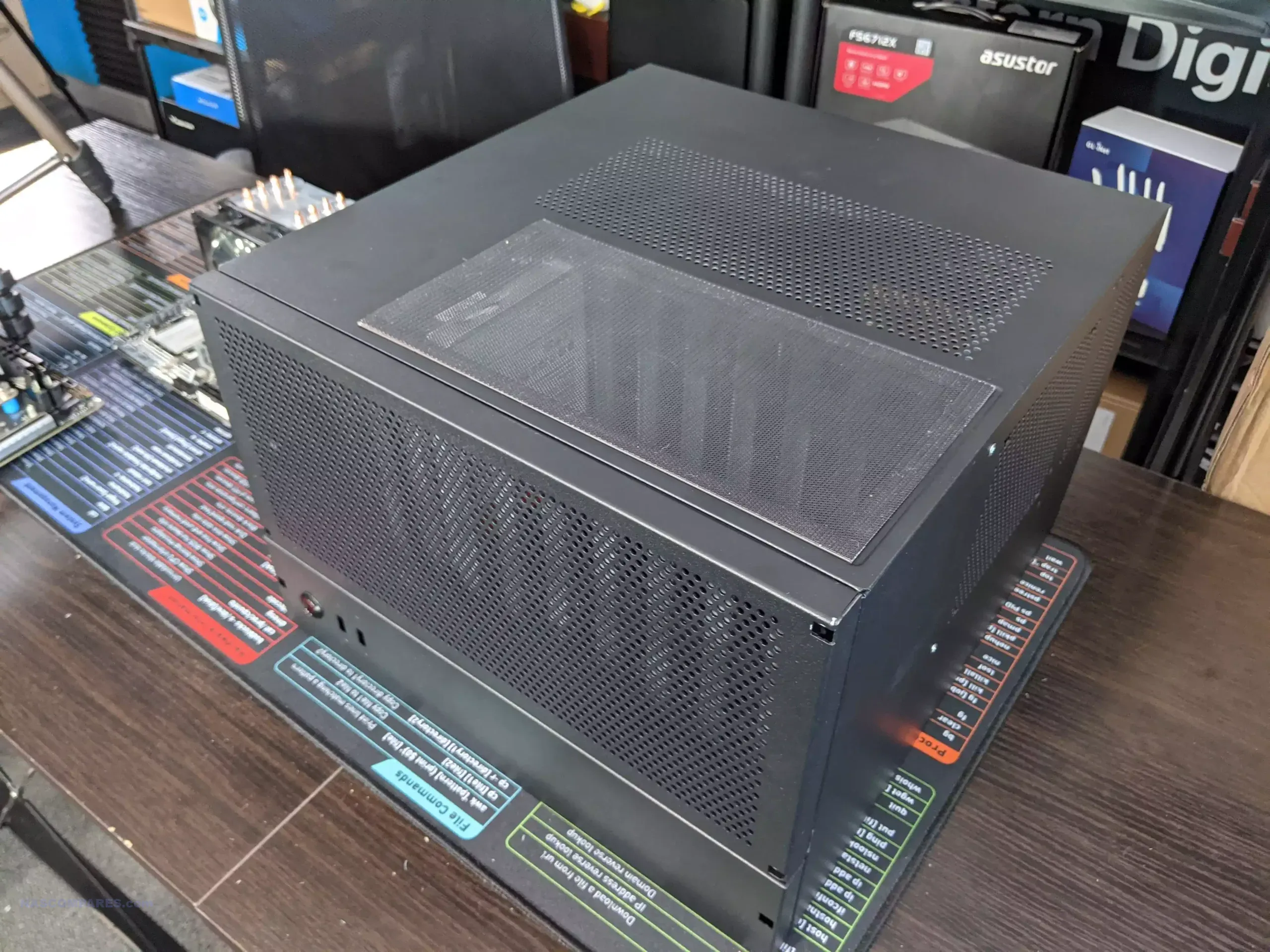
Phalcomm / STUDEVOX L8 8-Bay NAS Case Review – Quick Conclusion
The Phalcomm L8 NAS case provides a solid, compact option for DIY NAS builders, accommodating both ITX and ATX motherboards while supporting up to eight SATA drives. Its design is straightforward, featuring a durable steel enclosure with extensive passive ventilation on all sides, allowing for efficient airflow. With multiple fan mounting options—up to five fans can be installed—users have the flexibility to enhance cooling based on their specific needs. Inside, the case offers a spacious layout, making it easy to install components such as the motherboard, CPU cooler (up to 158mm in height), and PSU. However, some drawbacks include the absence of pre-installed fans, which competitors often include at a similar price point, and a lack of front-mounted features like drive trays or LCD panels. Additionally, the case does not come with essential cables like SATA or power, requiring further investment to complete the setup. Overall, the Phalcomm L8 is a well-constructed enclosure with room for customization, though users should be prepared for extra expenses to fully optimize its performance and functionality.
Phalcomm / STUDEVOX L8 Case Review – Design
The enclosure design is actually pretty ordinary, and it’s only when you realize that this system can house eight SATA storage drives and supports both ITX and ATX motherboards that the deceptively compact enclosure stands out. Arriving a fraction smaller than a number of other ATX motherboard-supporting NAS boxes in the market, this system has a relatively unique approach to drive injection that I will touch on later in more detail.
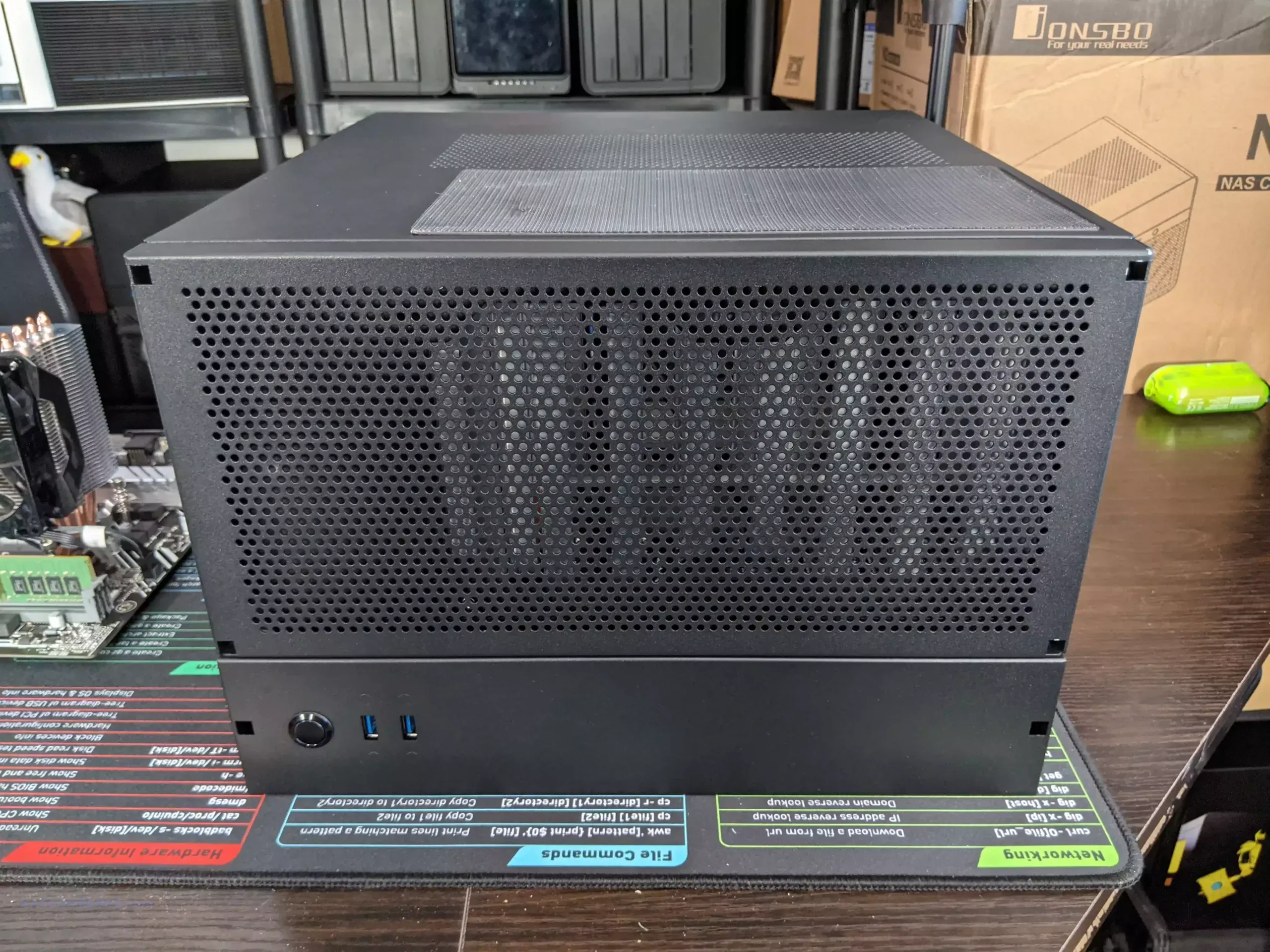
The front of the system is surprisingly low in detail compared with other NAS chassis. For example, there is a complete lack of front-mounted ejectable trays. The system features a front-mounted USB and its power button, but that’s really it. No included LCD panel, and little to no drive indication immediately visible. The casing is 1mm thick steel, in matte black, but is not available in any other color currently.
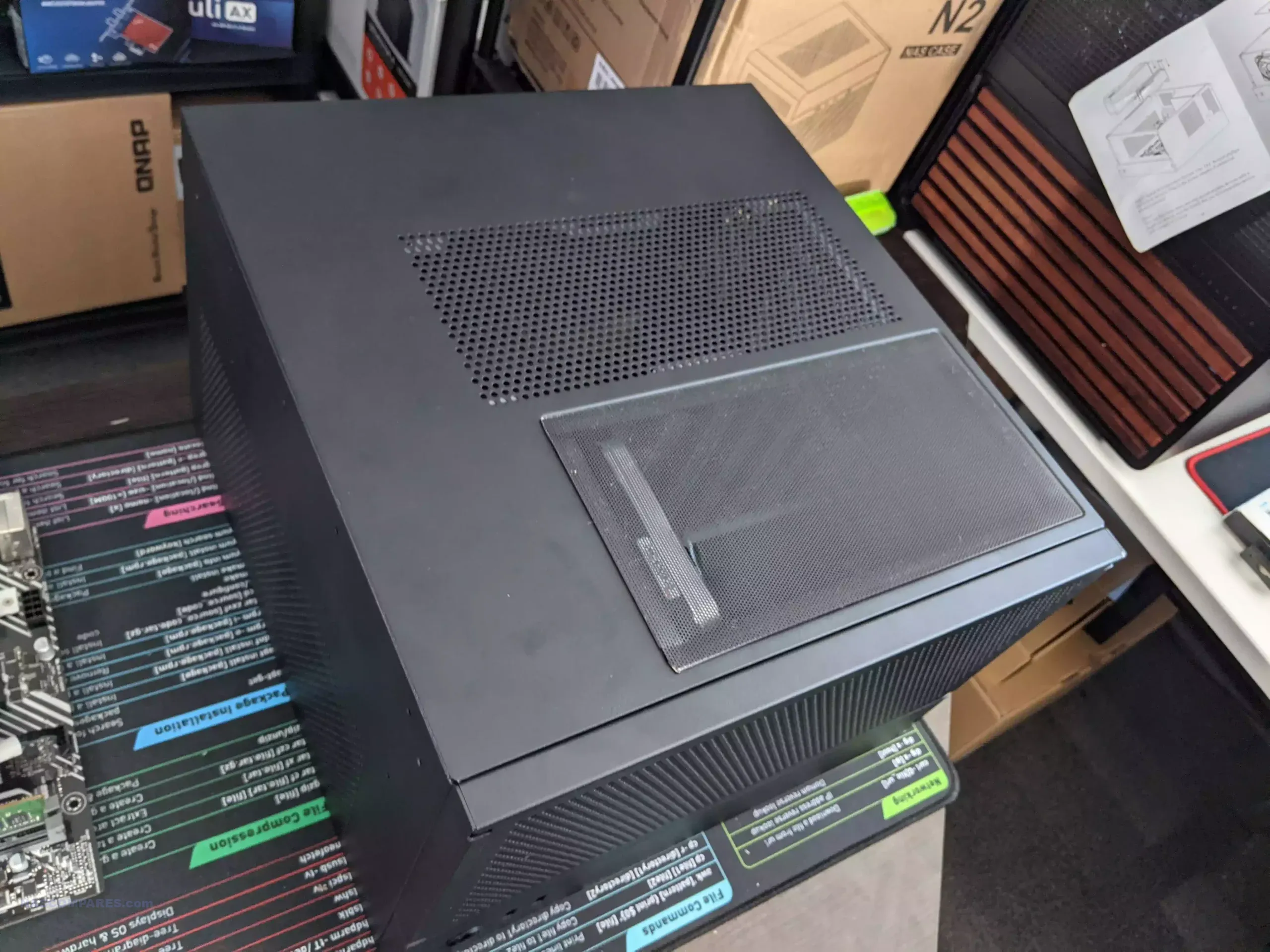
What the case does feature in excess is passive ventilation. With the exception of the base of the enclosure, the L8 features ventilation on every single side. Absolutely tons of passive airflow are going to be possible in every direction on this case when it is deployed. Passive ventilation is only half the battle, of course, as you will still need to factor in active cooling systems with strategically placed fans in order to facilitate that airflow throughout your components and ensure that the system remains at a highly operable and efficient temperature. However, it’s worth highlighting that the system does not actually include any fans with the enclosure.
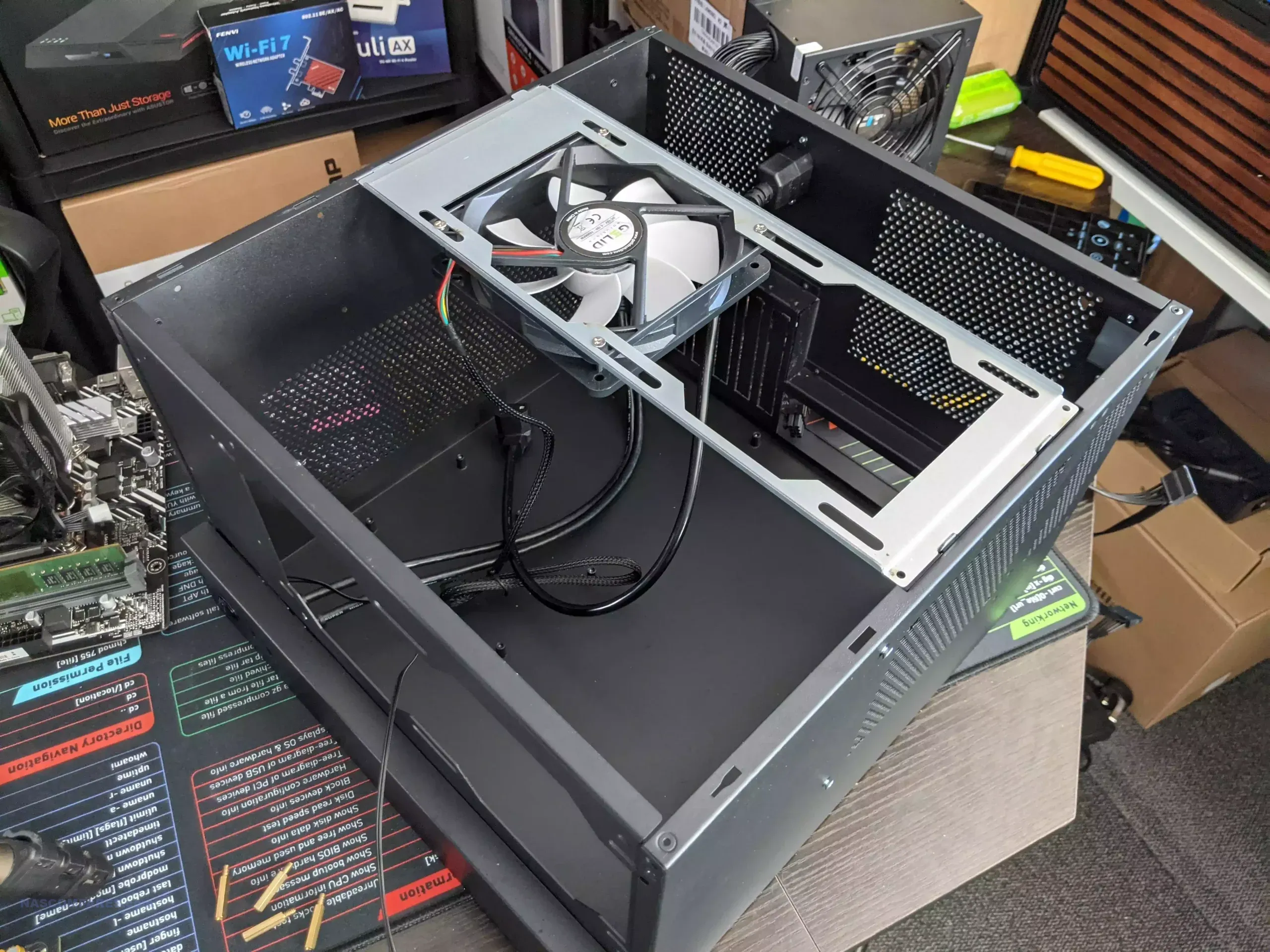
The case includes numerous screw holes and included screws for mounting fans in several different locations of the enclosure, but you are going to need to purchase these fans separately. For example, underneath the top panel of this enclosure, we find a rigid framing panel that rests over the top of the motherboard section and allows you to install two 120mm fans to supply active airflow to the motherboard.

Likewise, the rear of the enclosure also features screw holes for an 80mm fan to be mounted to draw further airflow across the internal components of the L8.
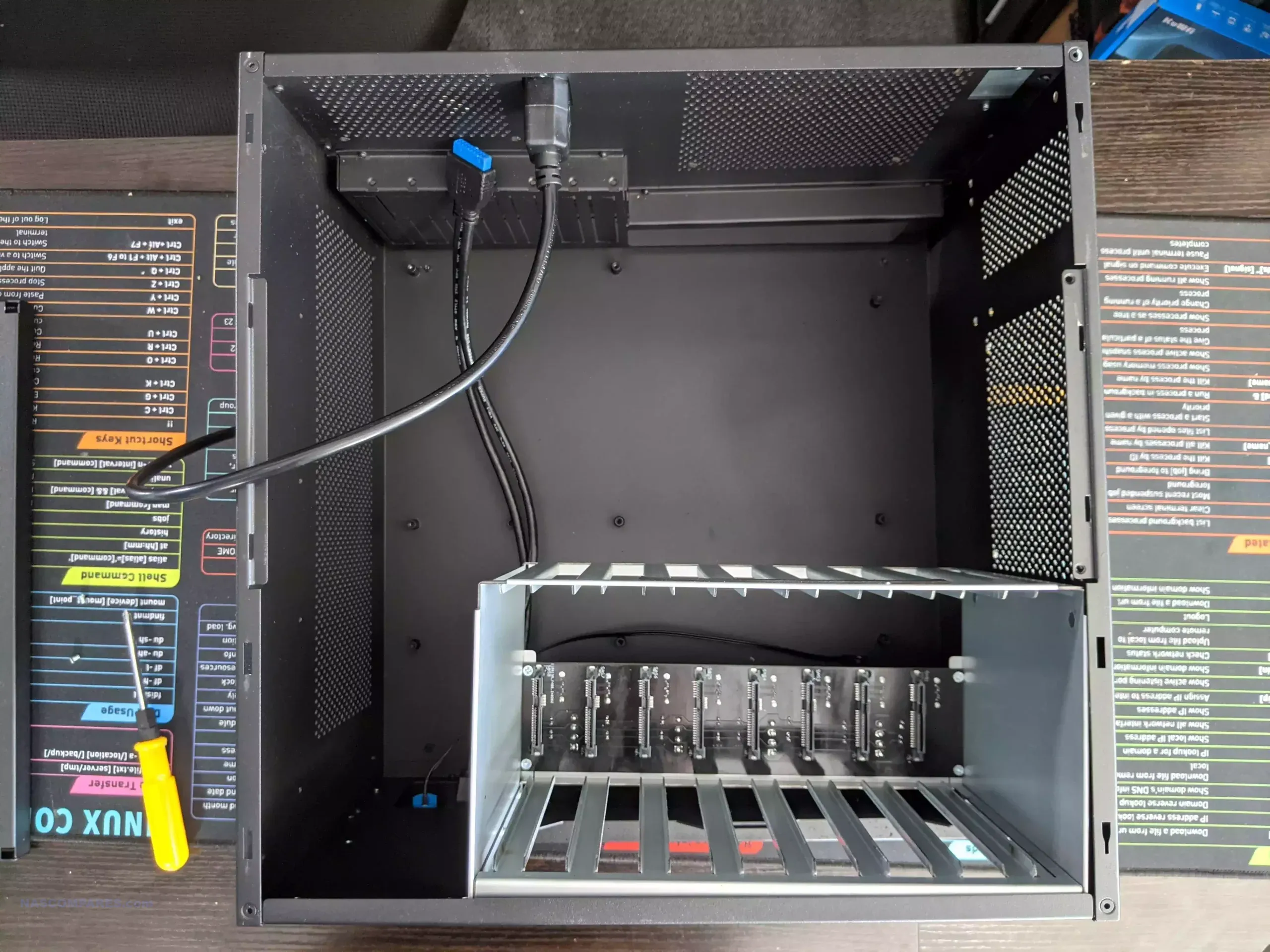
Finally, the front panel of the L8 can be removed to expose two individual 120mm fan mounting areas. This brings the total number of optional fans that you can mount on this system to five, which is pretty impressive for such a compact NAS chassis. Nevertheless, it does seem a little cheap for this system to not include even a single fan, when comparative NAS enclosures from brands such as Jonsbo and Highpoint all include active cooling fans alongside the empty enclosures as standard, at a similar price to this.
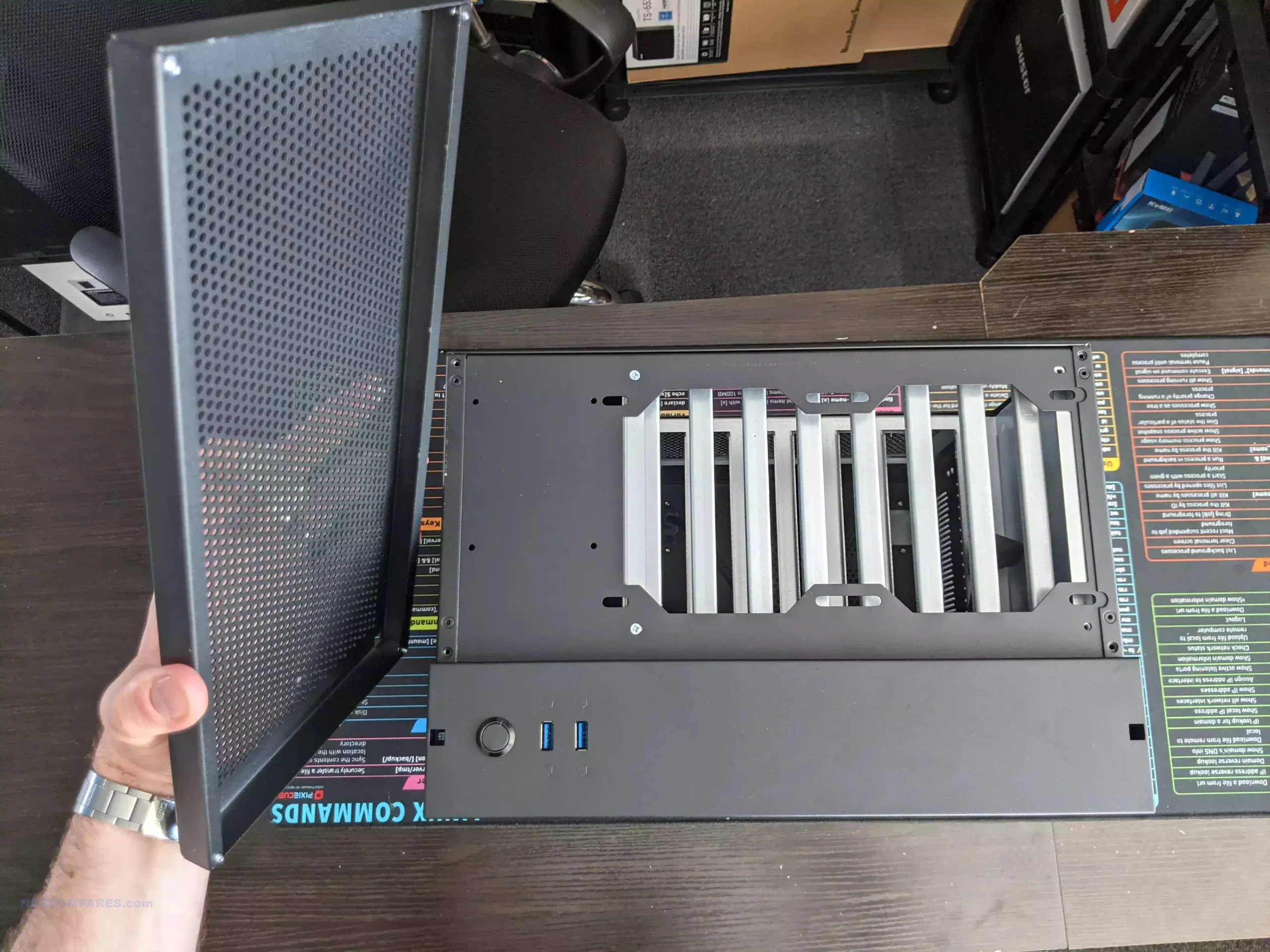
Additionally, you have to be a little selective on the fans that you plan to install in the front cavity, as space is a little compact. Although fans can technically be mounted on the inside of the enclosure to accommodate slightly larger models, this does protrude into the internal hardware a little and is far less desirable.
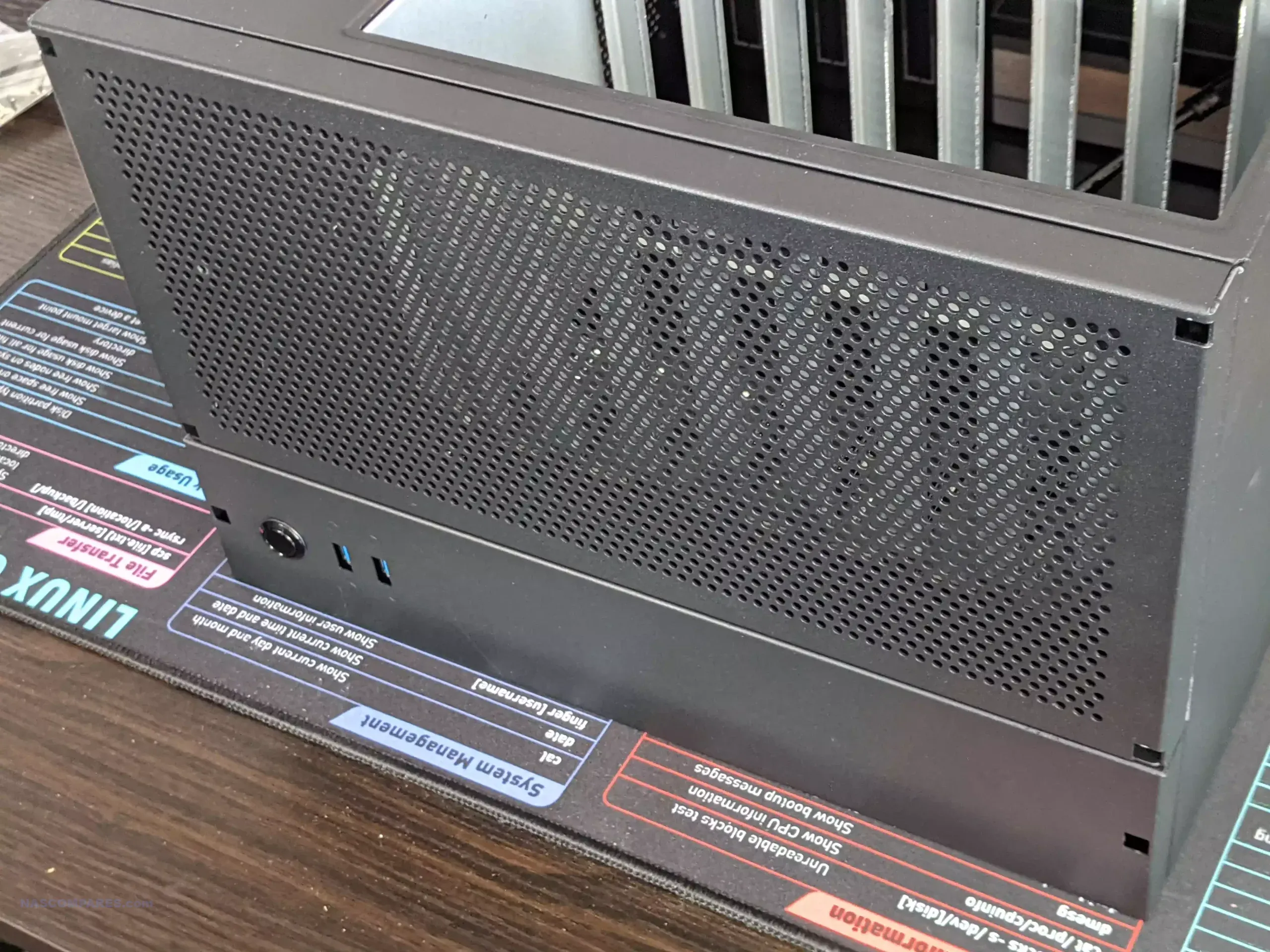
I can’t really fault the overall chassis design of the L8 in what it’s trying to achieve in providing a large scope for different NAS hardware configurations, but I really do wish the brand had put their hand in their pocket a little more and supplied active cooling fans with this NAS enclosure. Let’s discuss the internal build architecture of the L8.
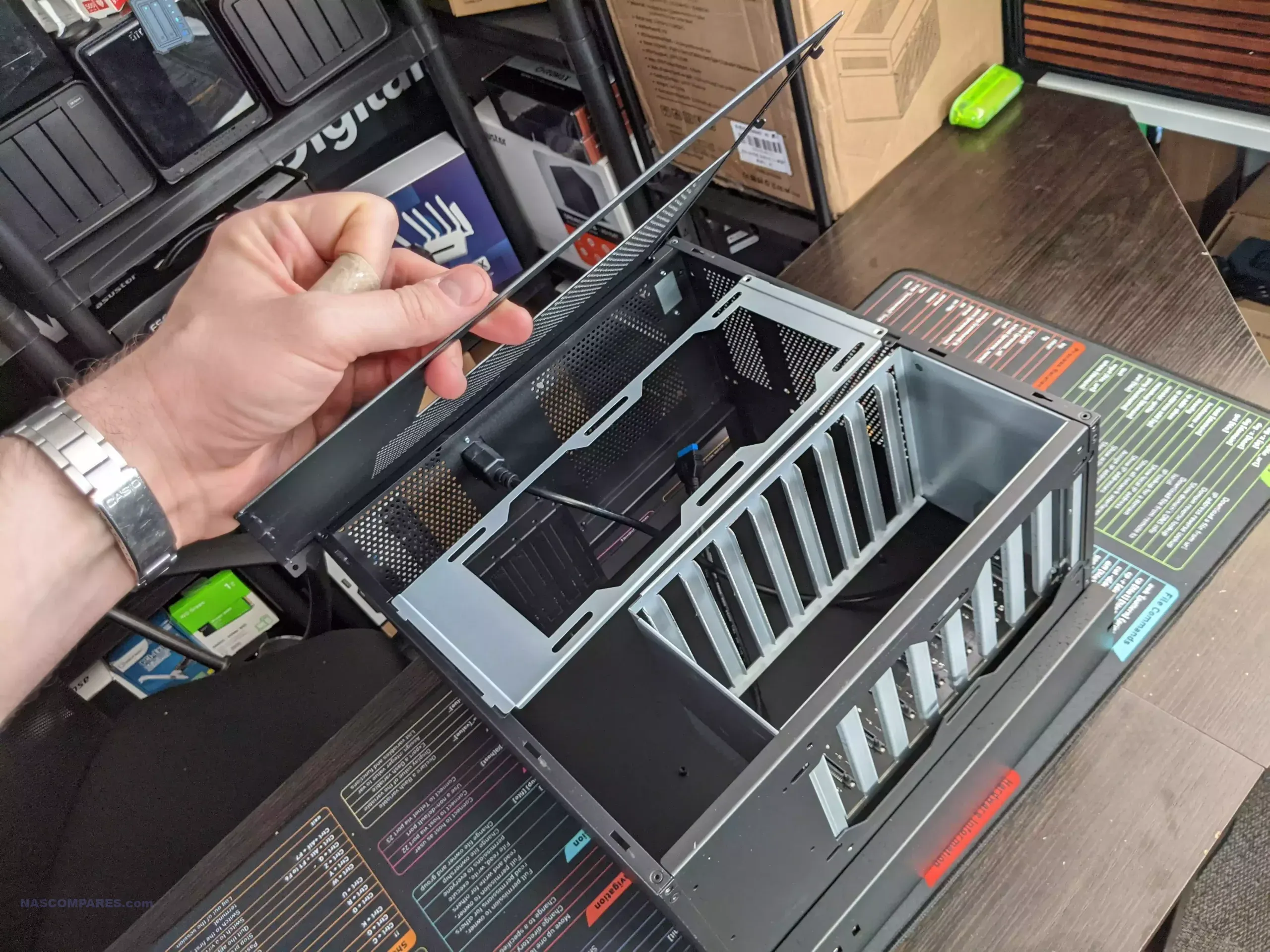
Phalcomm / STUDEVOX L8 Case – Inside
The top of the chassis is held in place by two screws on the rear of the enclosure, which, when removed, completely expose the L8’s internal motherboard, PCIe, and PSU installation sections, as well as the 8-bay storage cage that is mounted on two sides to the edges of the enclosure casing.
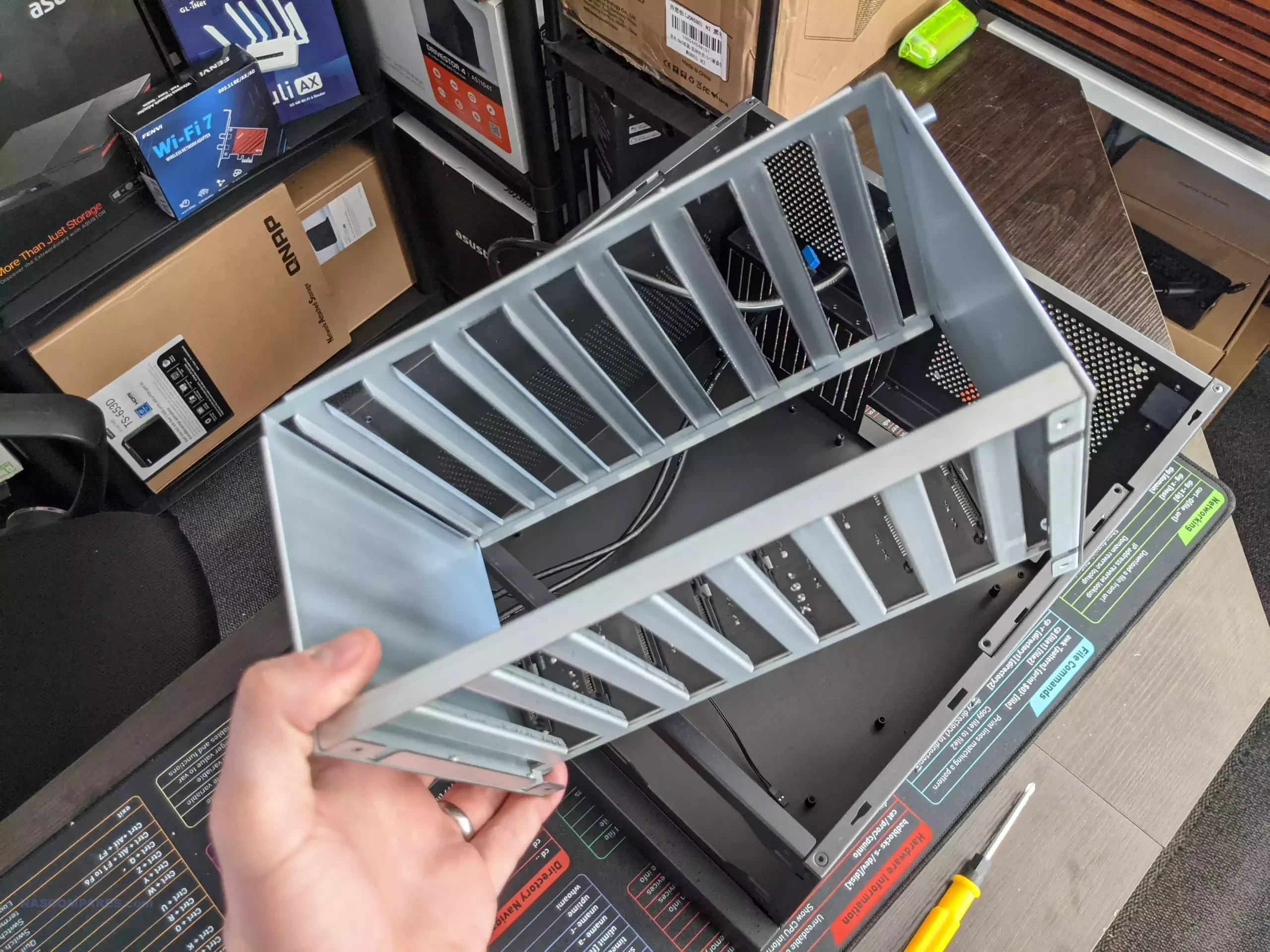
In order to access the cavity for installing your motherboard, you are going to need to remove that SATA storage cage. The system arrives with the cage fitted directly to an internal PCB that features individual data and power inputs. However, the system does not arrive with SATA cables, Molex power cables, or any of the small but crucial extras you are going to need to build a NAS here. Removing the SATA cage temporarily shows us the full internal cavity and all of the individual mounting screws for different kinds of motherboards clearly accessible.
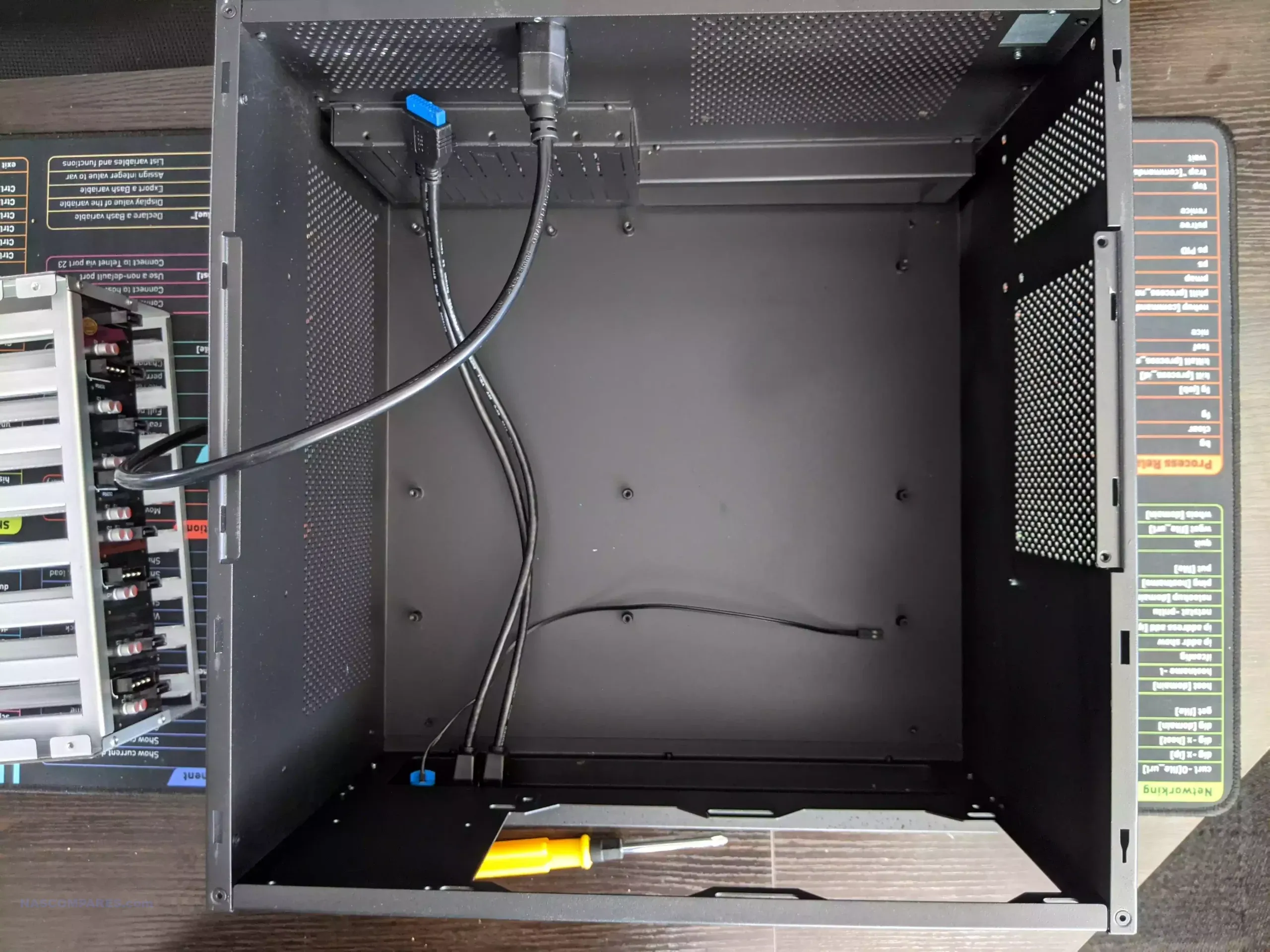
There’s actually a fairly massive amount of space afforded to the motherboard and CPU cooler installation. This enclosure supports CPU coolers up to 158mm in height, which is pretty generous for both ITX and ATX NAS motherboard deployment. I will touch on slight spacing concerns between the CPU cooler and the PSU later on, but for now, you can see via the image below just how much space is afforded to you and how little space an MITX motherboard takes up when installed inside here, even with my tallest CPU cooler installed.
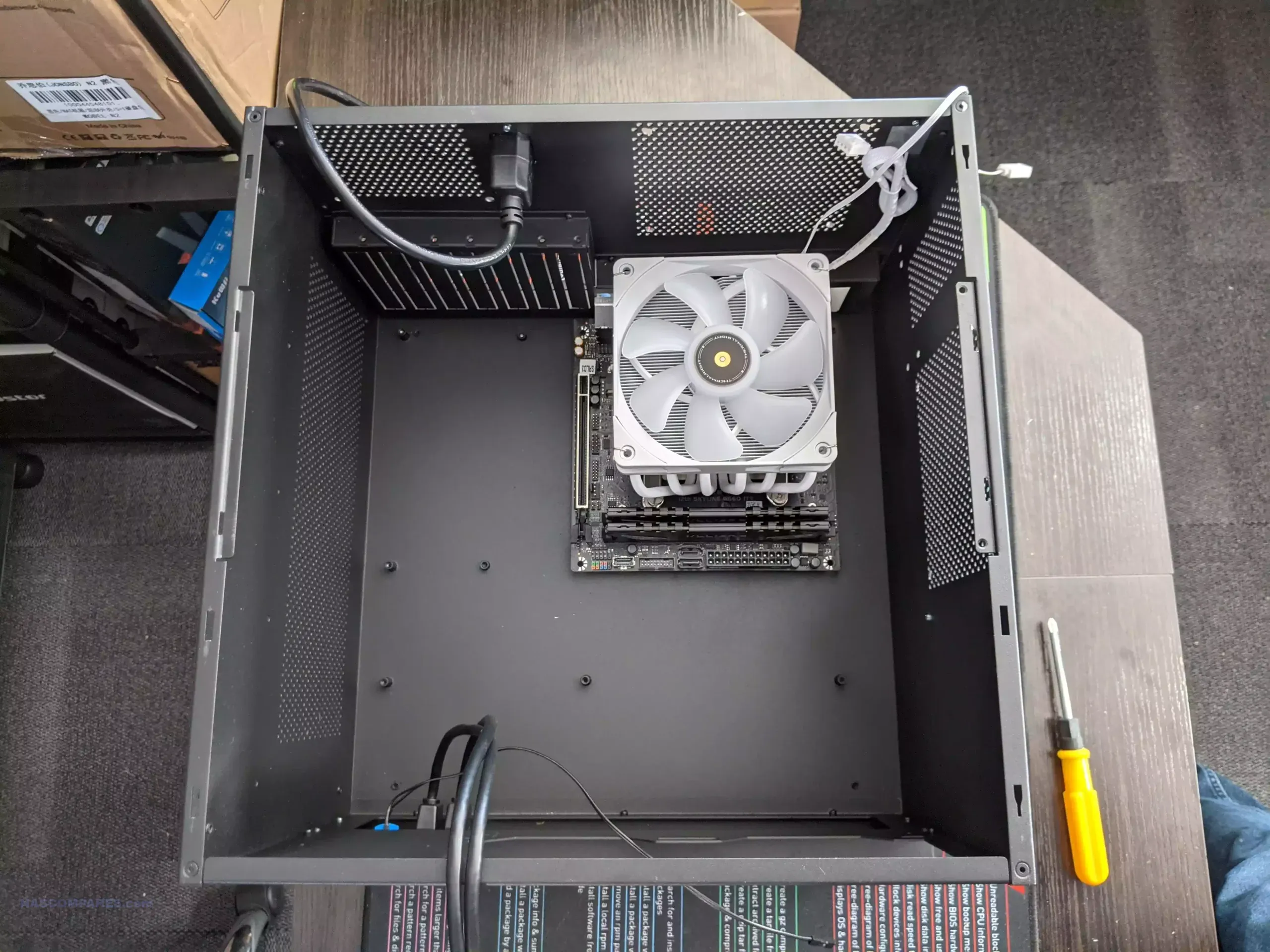
Likewise, even when I installed an M-ATX motherboard, there was still plenty of room to play with, and as long as you aren’t going to be utilizing a particularly aggressive CPU cooler on your 24/7 NAS server deployment, there’s lots of room for growth here.
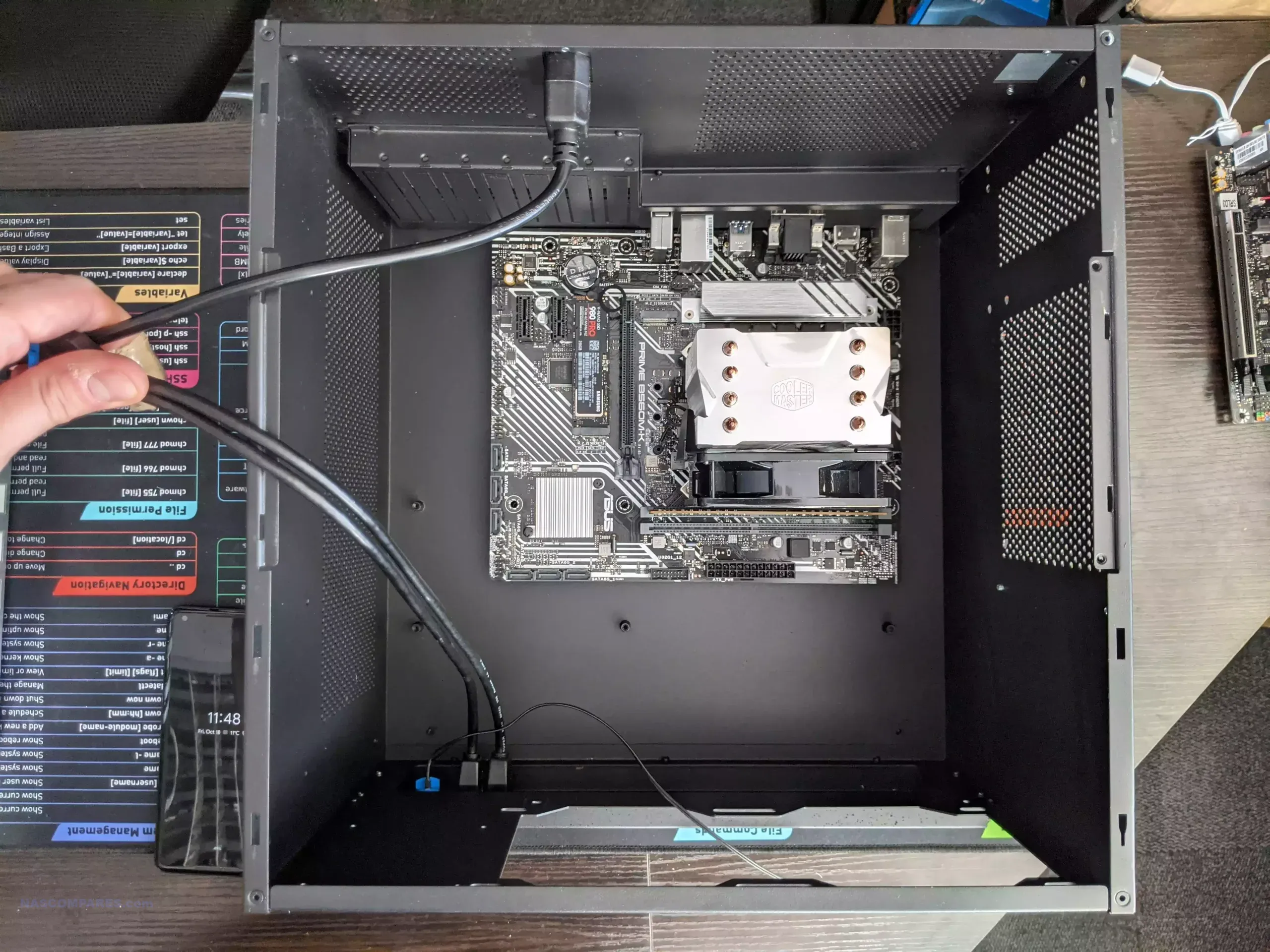
Additionally, despite this case being a little compact, it features a myriad of PCIe expansion slots that can be punched out on the exterior of the enclosure. Thanks to modern PCIe risers, intelligently built expansion cards, and M.2 to PCIe adaptors in the market, it’s actually surprisingly easy these days for a NAS user to find ways and means to fully utilize all of that PCIe upgradable goodness.
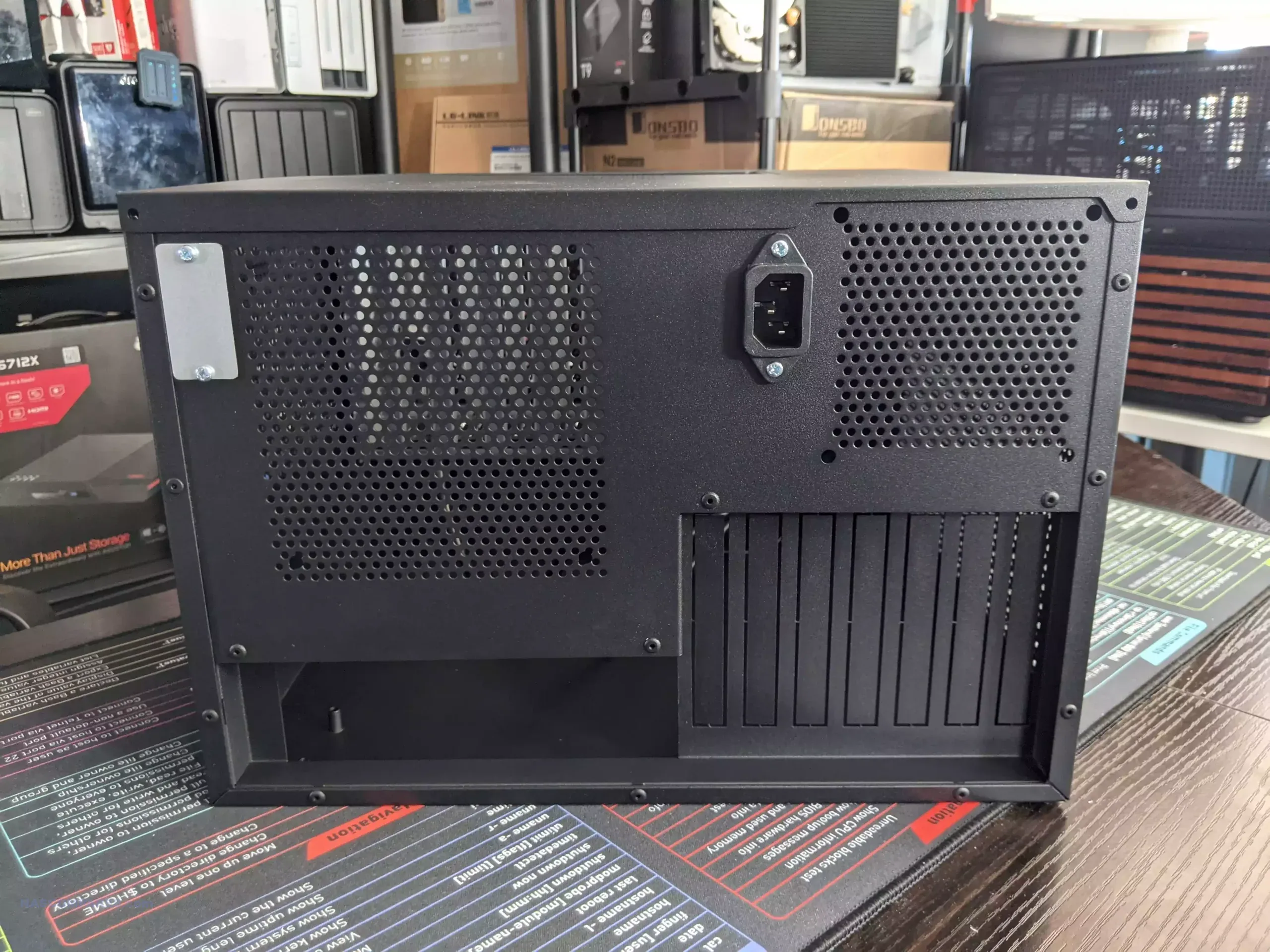
This, however, leads me to the installation of the PSU/internal power supply in this system. In order for its rather compact design to work, certain creative choices have been made to install a PSU comfortably around the other components. Like a few other more compact NAS enclosures on the market from well-established brands, the L8 features an internal mains power extension cable. This means that although the external rear casing features a mains power female socket, it is in reality feeding into an extension cable to the location of the PSU block, which actually lives at the front right of the chassis.
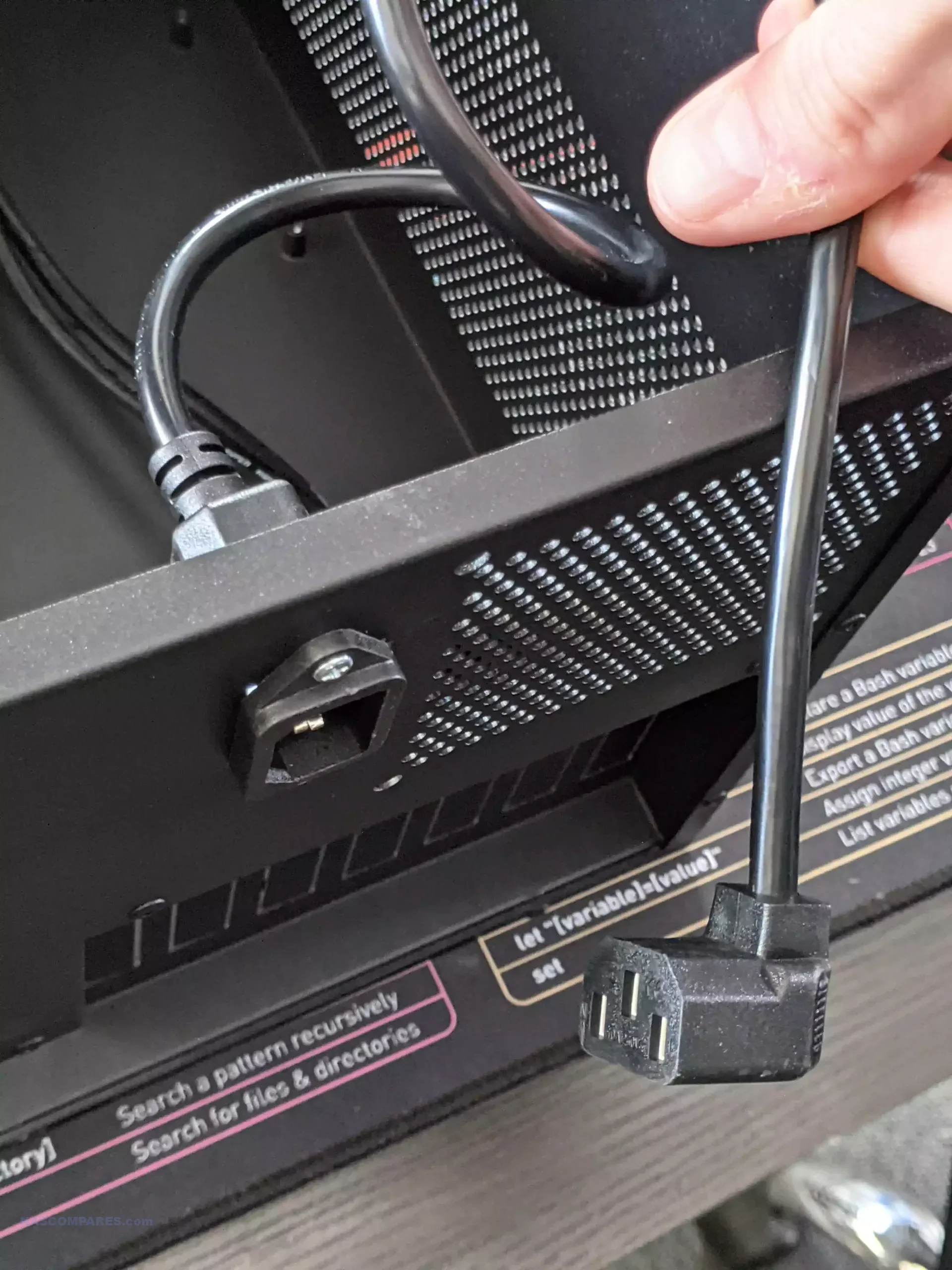
The mounting of the PSU inside the L8 case is actually a little unique. The PSU is held at the top of the casing via four individual copper risers that not only hold the PSU in place in its raised position but also ensure that the PSU is around 1-2cm away from the enclosure wall, ensuring enough space to use the angled mains power cable correctly while still ensuring that the PSU fan is angled appropriately toward the enclosure’s ventilation panel.
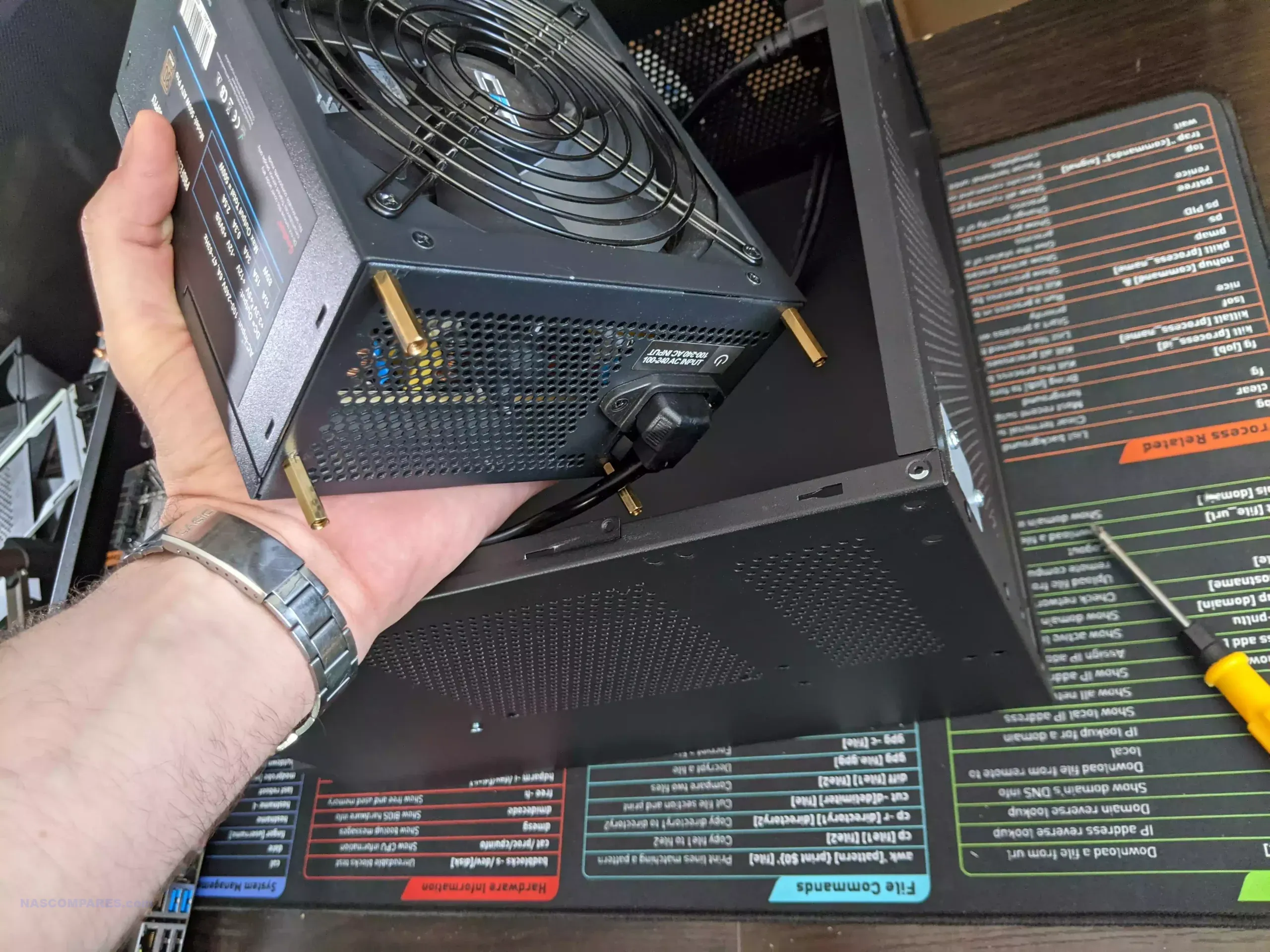
Nevertheless, we DO need to discuss the elephant in the room. Namely, the proximity and placement generally of the PSU in conjunction with the CPU Cooler. IF you plan on using a lower profile CPU cooler, then this will be zero issue at all. However, the maximum of the CPU cooler size and PSU (namely 158mm and 160mm respectively) result in a tremendously close placement of the CPU fan and the internal PSU.
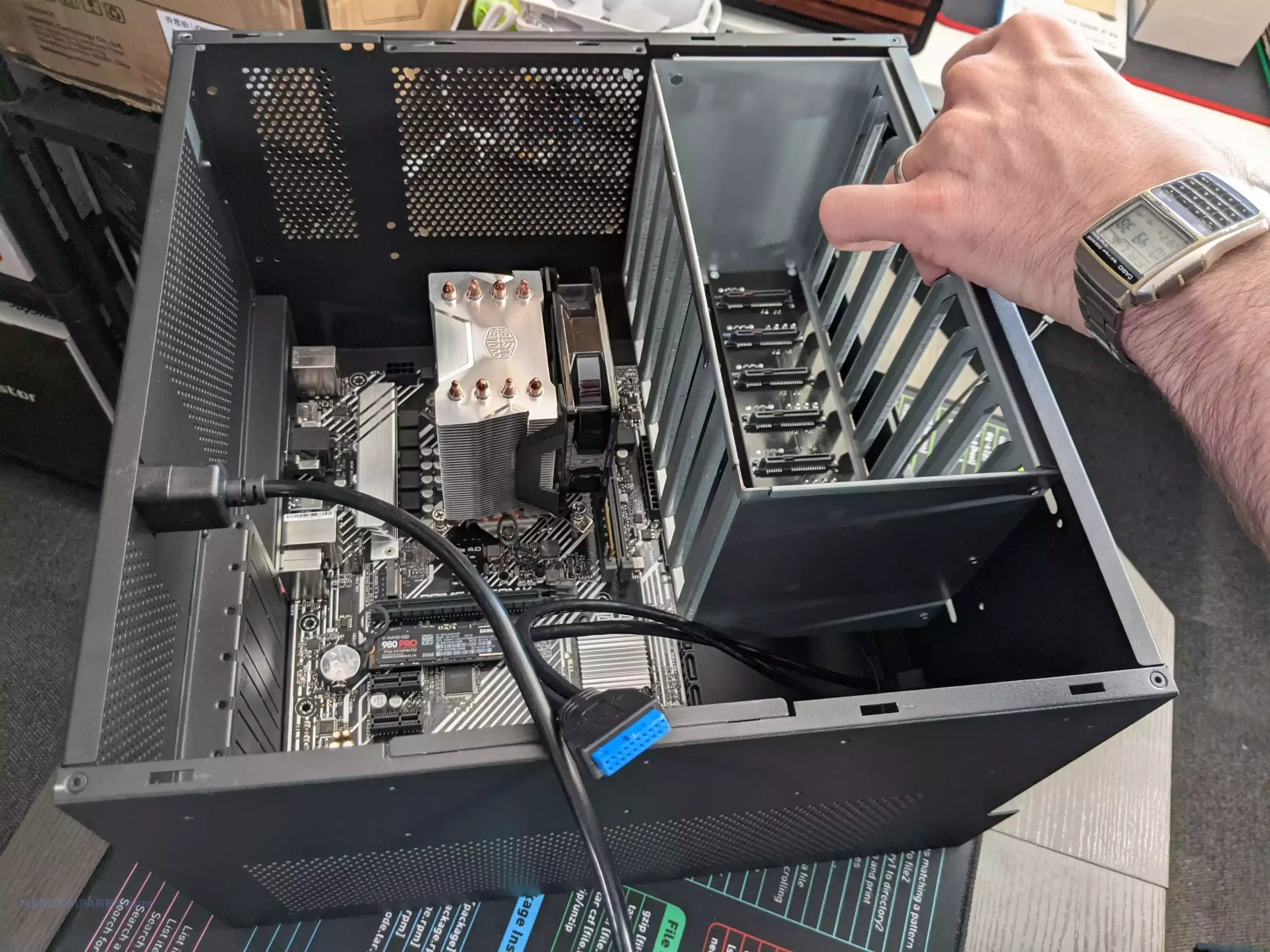
This is by no means a deal breaker, but it is worth keeping this in mind when looking at a compact case like this that it can impact a lot of the component placement. A NAS is designed to be on 24×7 so there is of course the argument that high end power-use deployment is not going to be as common as gamer PC building, so larger CPU heatsinks and powerhouse PSUs are less used in server use (electricity bills!), but there is no avoiding that the placement of the PSU and CPU fan are, in efforts to keep this case compact, very close indeed!
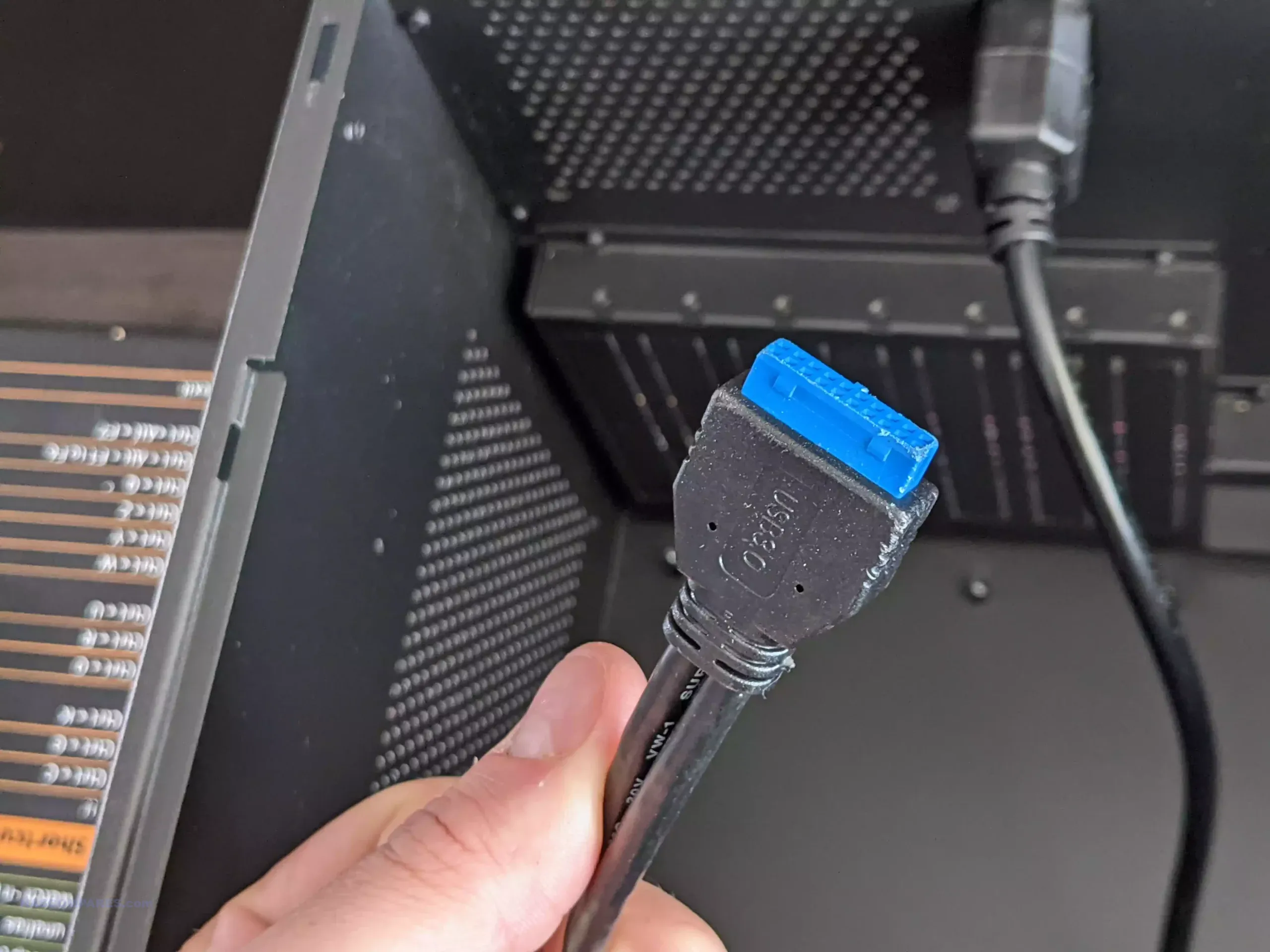
The F Panel cable is fairly standard, but its a little bit of a shame that it only supports 5Gb/s and USB Type A only (so no USB-C or 10Gb/s USB 3.2 Gen 2 support – which is increasingly common on even the most modest NAS optimized mobos from Topton, CWWK, etc). Not ‘bad’, but a little underwhelming for the price in 2024/2025.
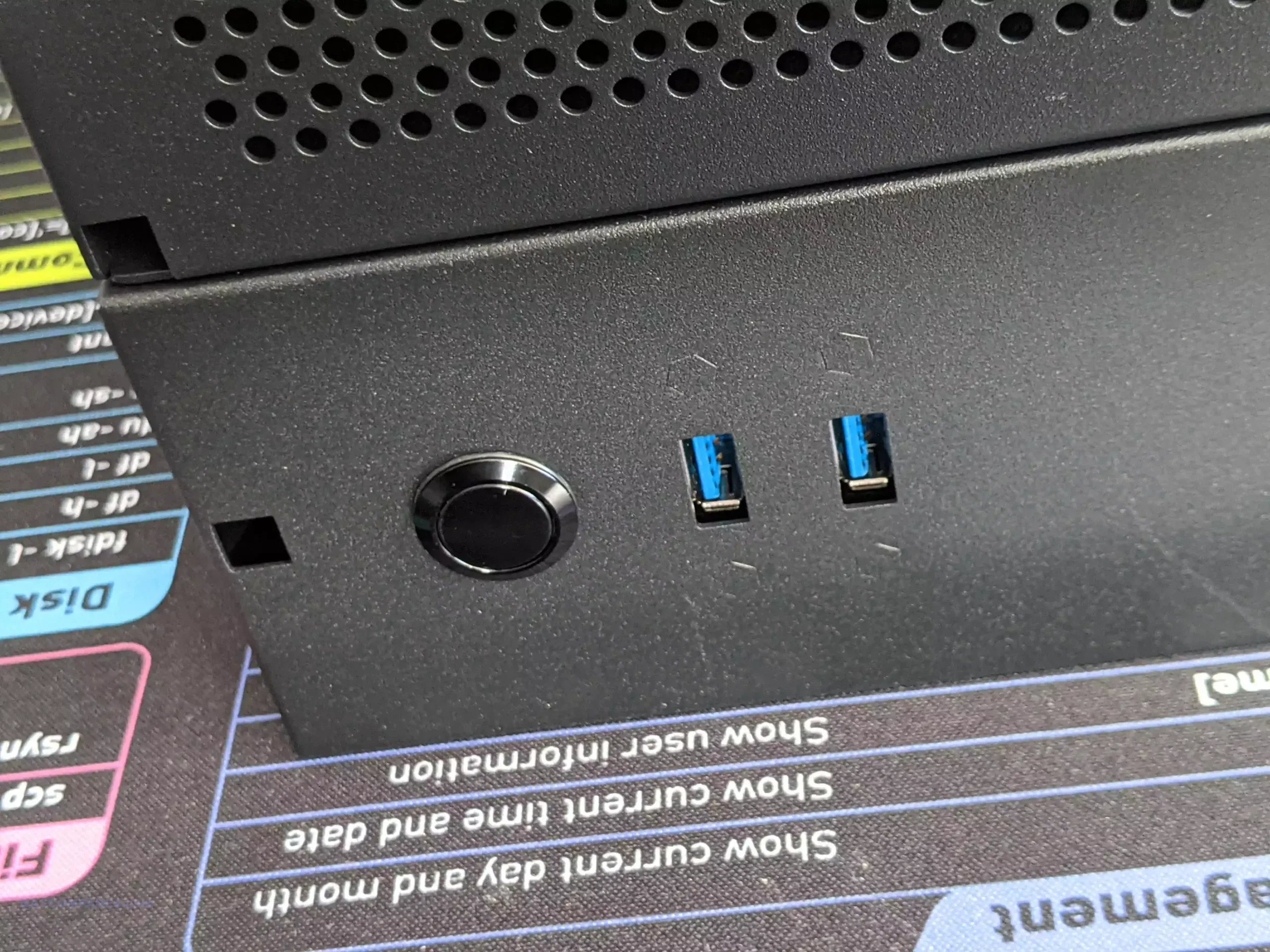
Overall, you cannot fault the build quality internally, but the scope of deployment and how much you can do with the afforded space is oddly conflicted. Let’s discuss the storage capabilities of the phalcomm L8 NAS Case.
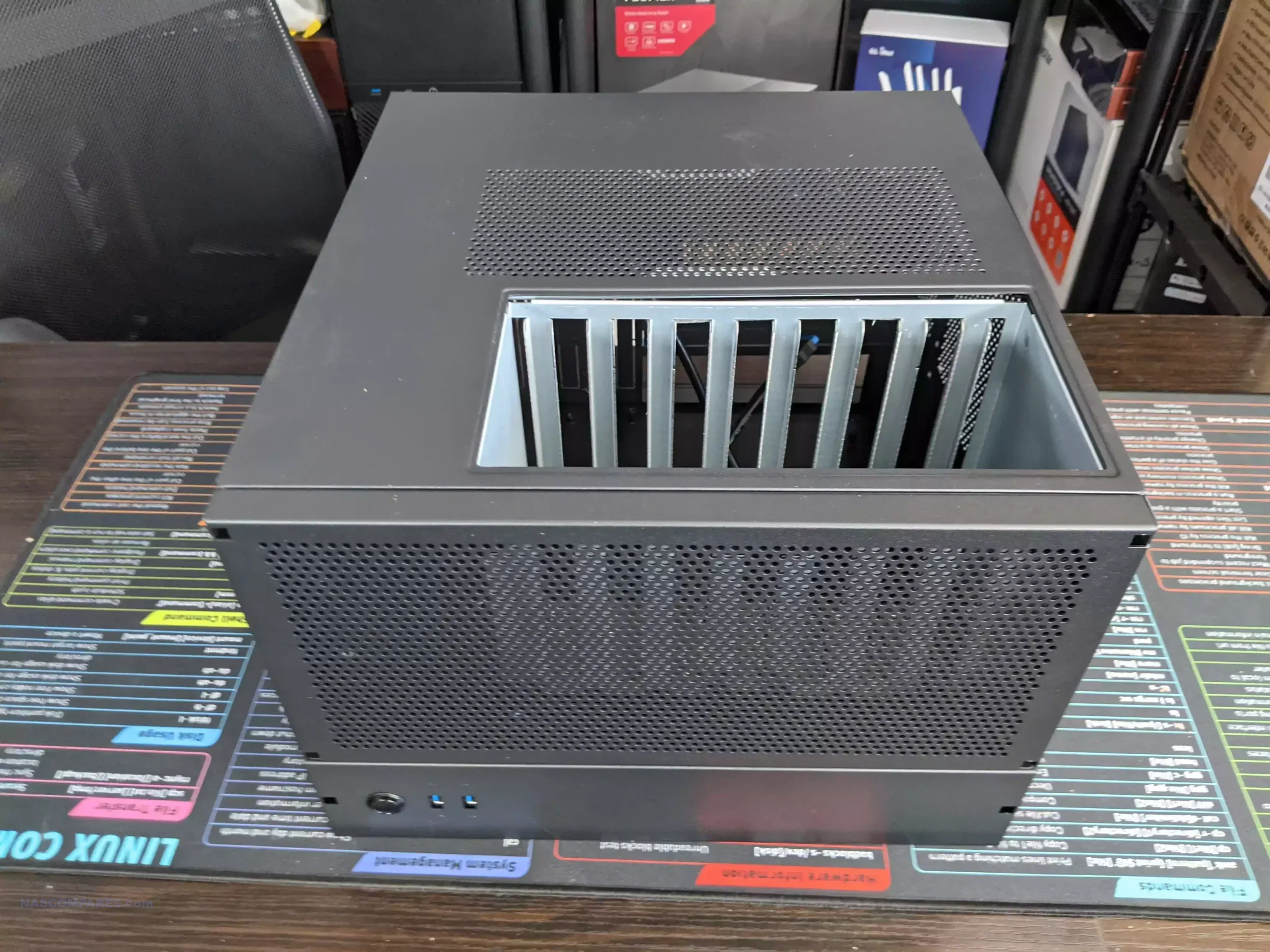
Phalcomm / STUDEVOX L8 Case Review – Storage
This is possibly the things that left me so hot/cold about the Phalcomm NAS Case. On the face of it, ATX Mobo NAS cases are oddly rare when compared to the range/availability of more compact M-ITX NAS enclosures – even more so when you factor in that the L8 is trying to be a compact MATX/ATX NAS case. Nevertheless, I am a little perplexed by some of the design choices here. The choice of drive injection is unique! It’s convenient, saves on wasted materials towards HDD/SSD Trays and allows for very, very easy to access storage media bays.
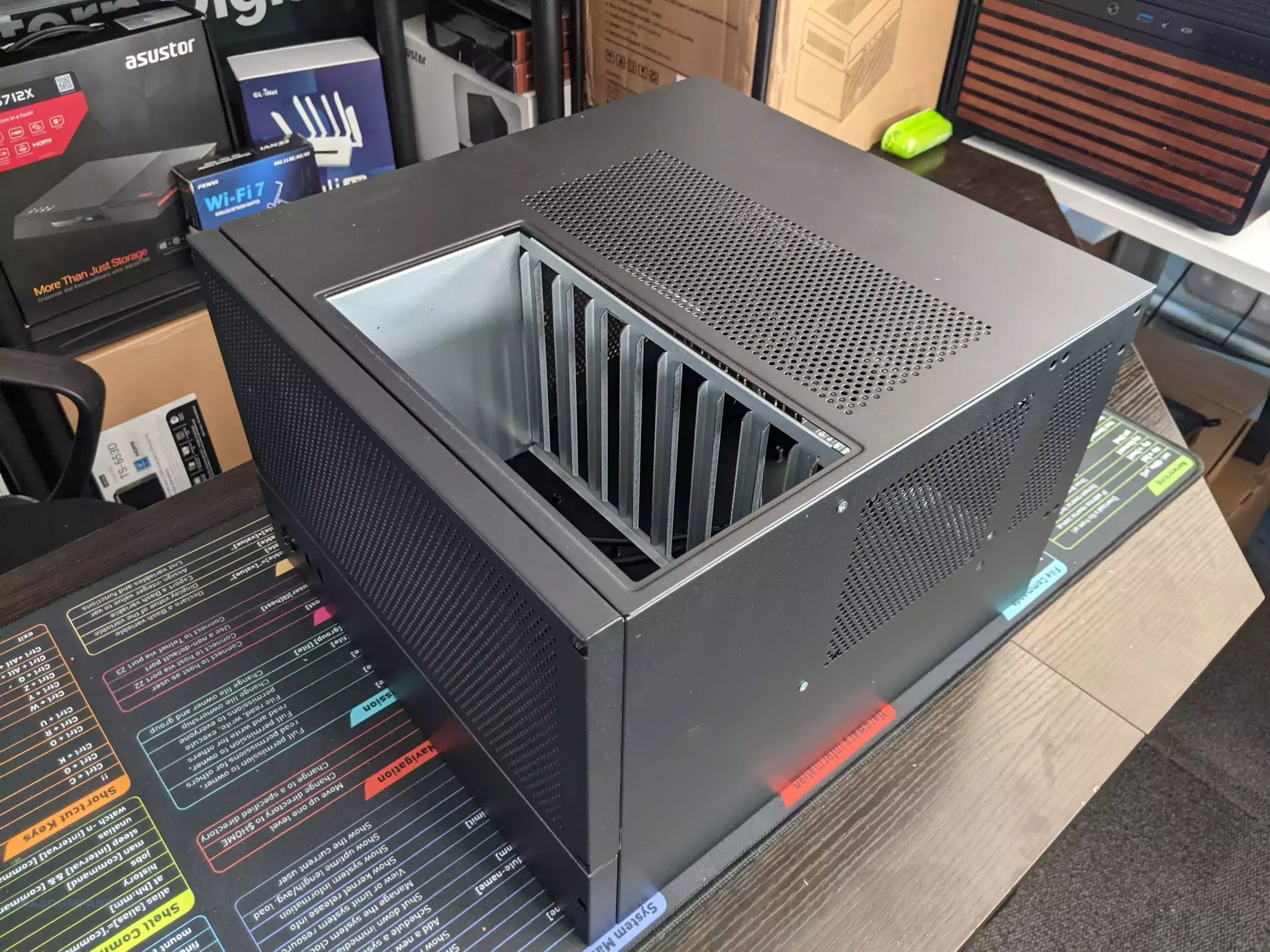
Additionally, the 8x SATA media bays also feature a magnetic dust capture panel that can be applied above the HDD bays in order to reduce detritus build up over time. However, this panel definitely feels a little cheap and does not quite sit neatly above the HDD bays. I always had to carefully lay the panel over the HDD cavity to ensure it neatly covered it – it never felt particularly premium. I know how ‘precious’ that sounds, but the panel is not rigid, so if you do not specifically lay out the panel over the cavity ‘corner to cover’, it just ends up looking a little slap-dash. I am glad its there, but I wish this panel was rigia and felt for ‘cut to shape’.
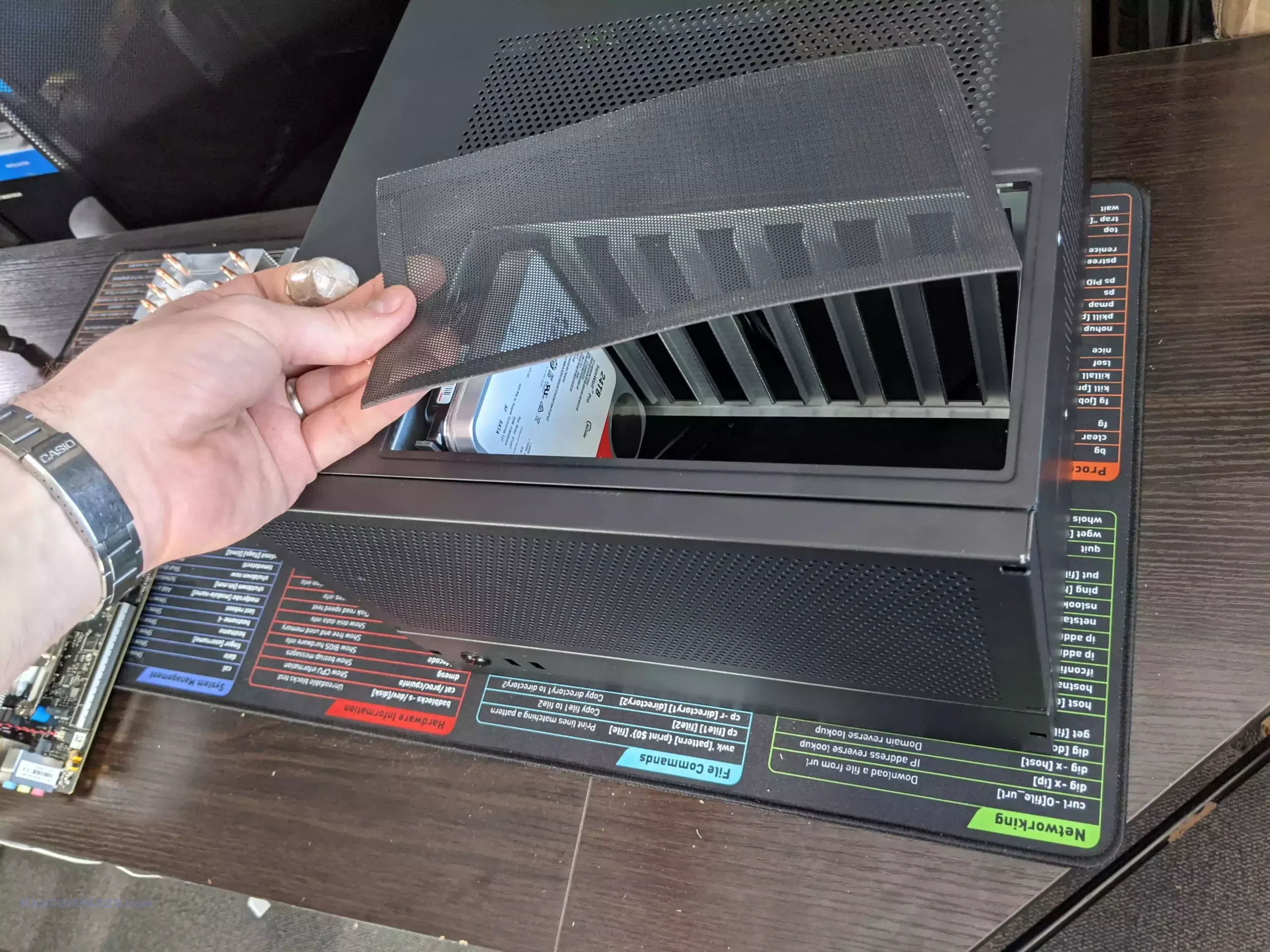
Another thing I have mixed feelings over is the way in which the HDDs are injected into the L8 SATA Drive cage. Each drive needs 2x HDD clips to be attached (3 screws each) and that allows each drive to slide into the runners on each bay – this is all well and good. However, these clips are not in any way rubberised, do not have any kind of absorbance for ambient vibration (unlike a silicon or more permeable material) and that means that in the case of more enterprise/large-cap drives, the vibration will be amplified, rather than dissipated.
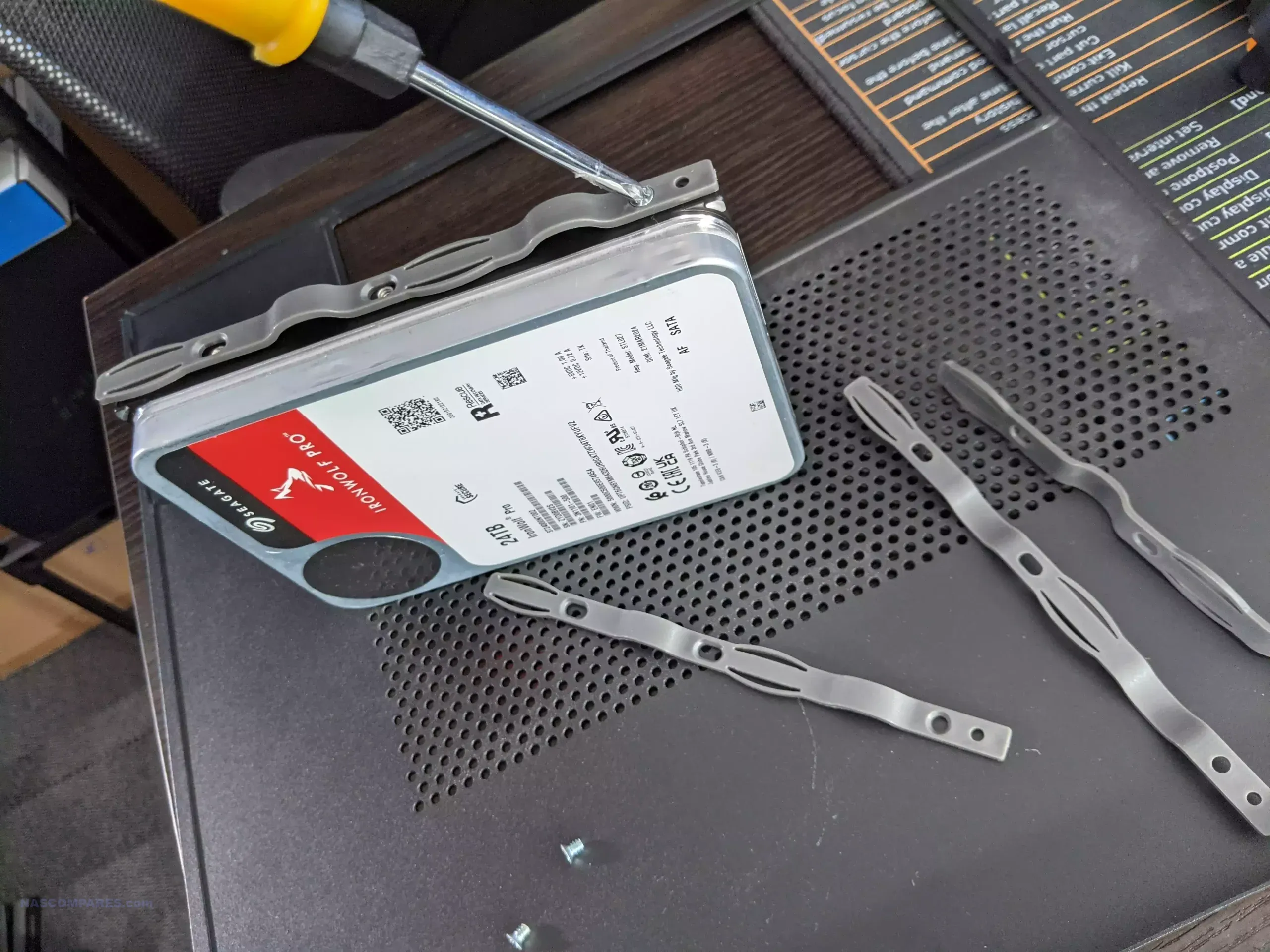
Again, this is not a deal breaker! But with so, so many NAS cases in the market that arrive with easy to inject/eject HDD trays, I always find it odd in 2024/2025 that companies like Phalcomm and Jonsbo still use these kinds of HDD accessories in their NAS systems.
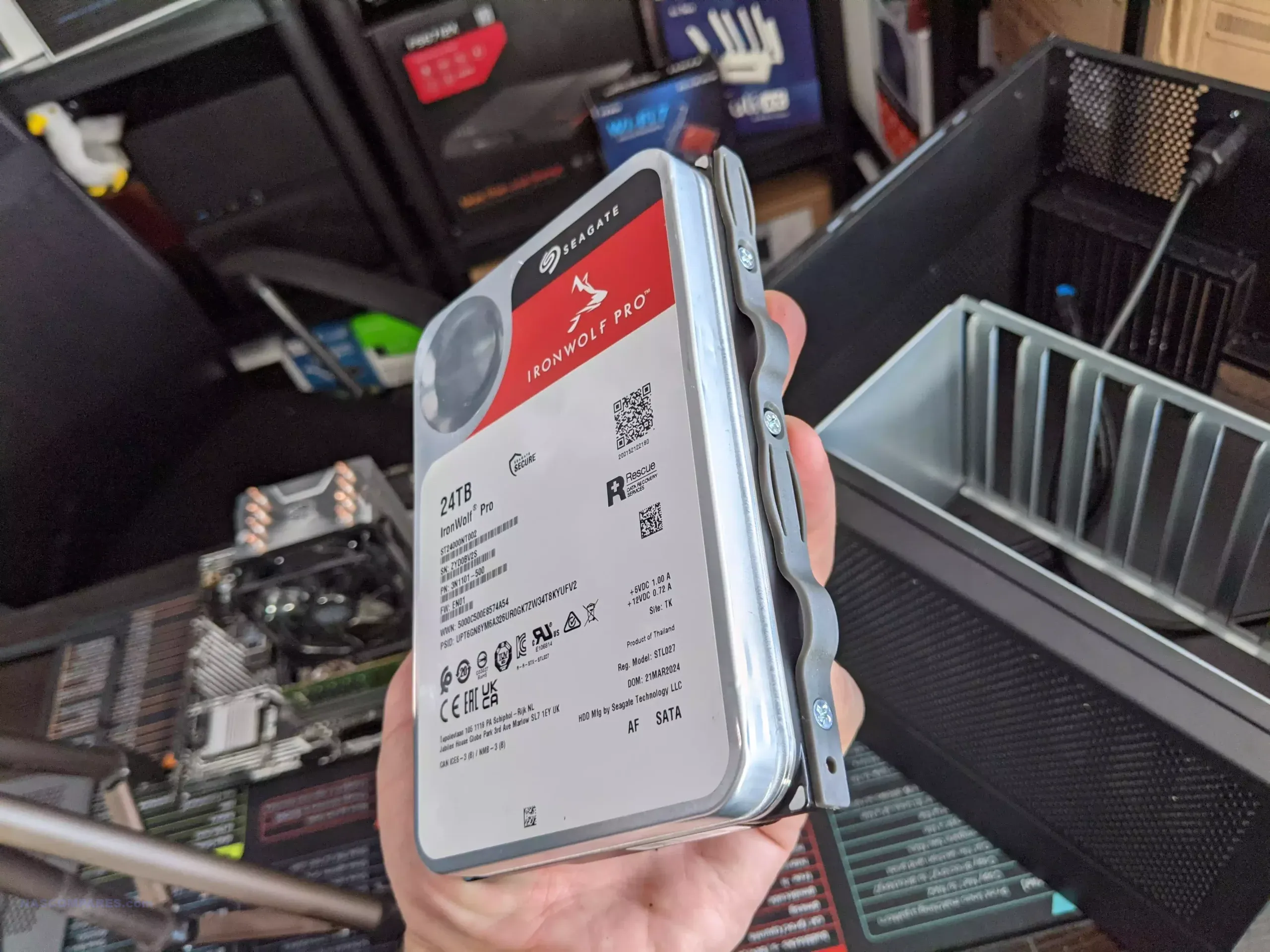
When I installed smaller 4TB Seagate Ironwolf HDDs, they slide into each HDD cavity smoothly and without issue! However, when I installed a 24TB (10 platter) Seagate 24TB Ironwolf HDD – it did NOT go in smoothly and you definitely got the impression that injection and ejection of larger drives was going to be a little more friction filled.
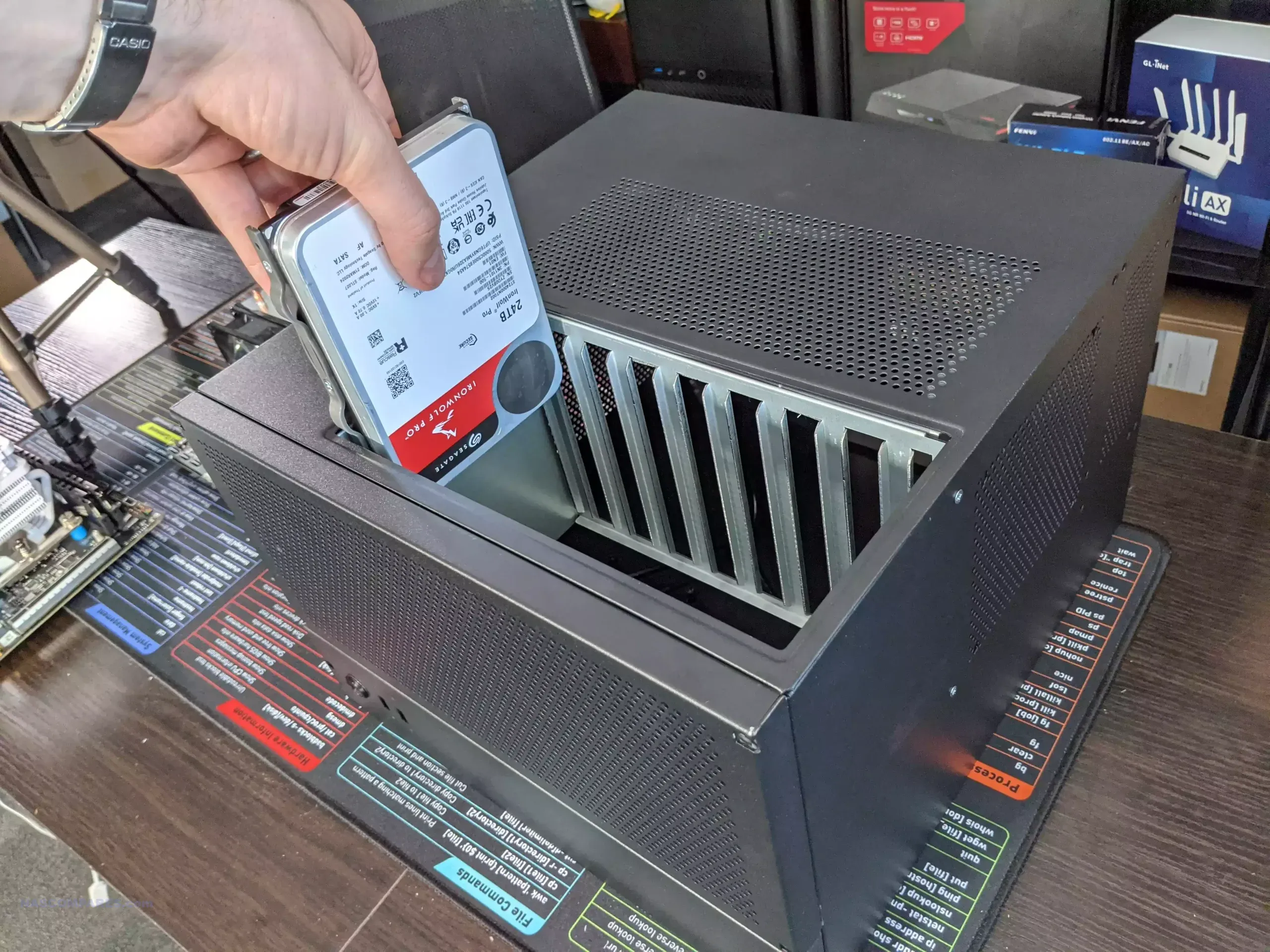
Also, speaking of ejection, removing an HDD from the L8 enclosure was a less than elegant too. There is no ejection button, no handles for each drive bay and the only way to remove an active HDD (eg, in the event of an HDD failure in your RAID pool in order to introduce another one) was to grip the HDD by your finger tips and pull it out. It’s by no means the end of the world, but its pretty messy compared to if they had just equipped the system with HDD trays into each bay that were springloaded or just button ejection
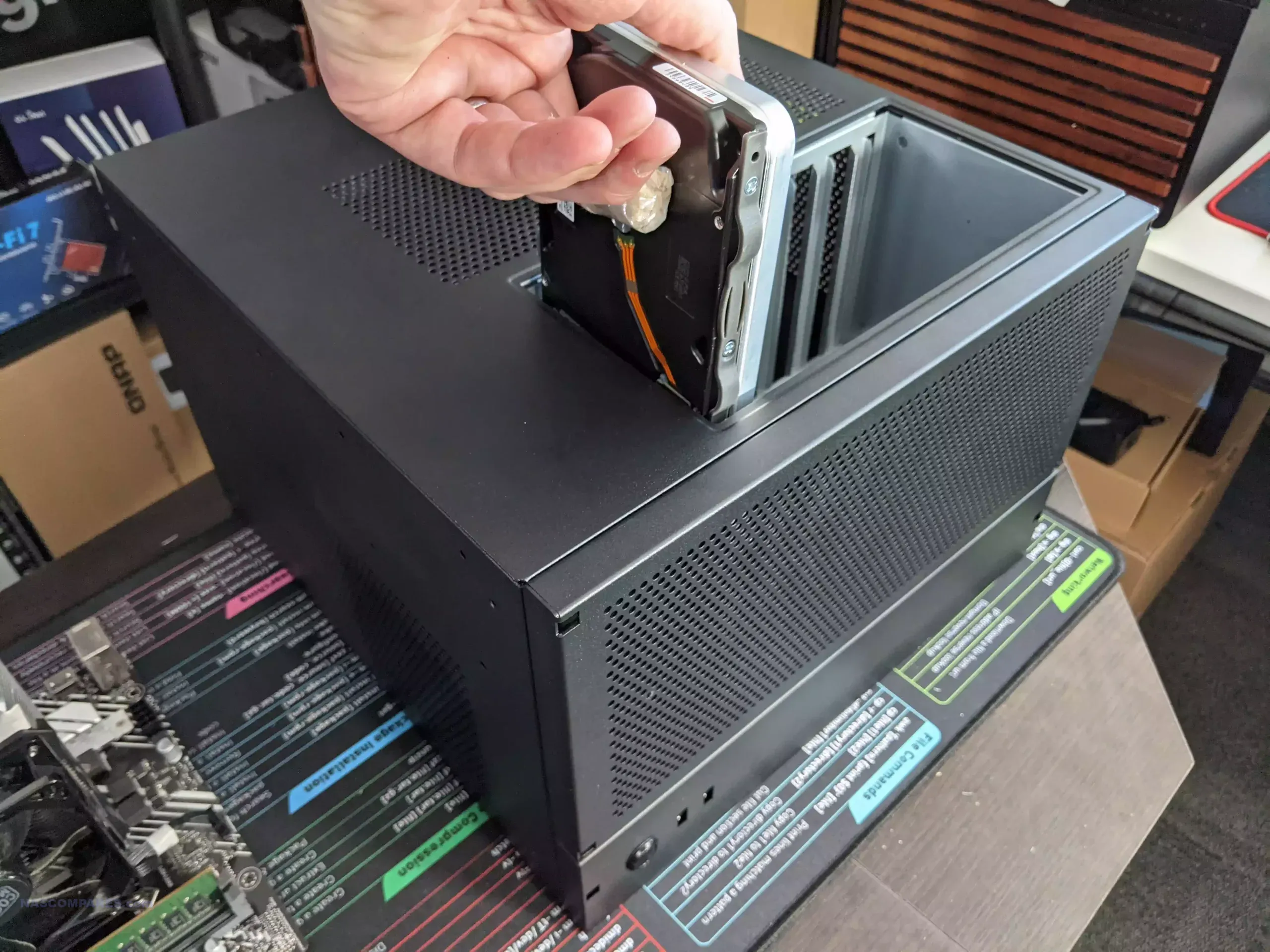
I know it seems likes I am being very picky here – but the lack of smooth trays on the L8 really do hurt a lot of the impressively compact design choices on show here. Verticle HDD deployment has some great advantages in terms of space saving and redirecting active airflow throughout the system, but the way that drives are being injected into this system is not as smooth and seamless as the promotional images of the case would suggest on the websites that this case is being sold on.
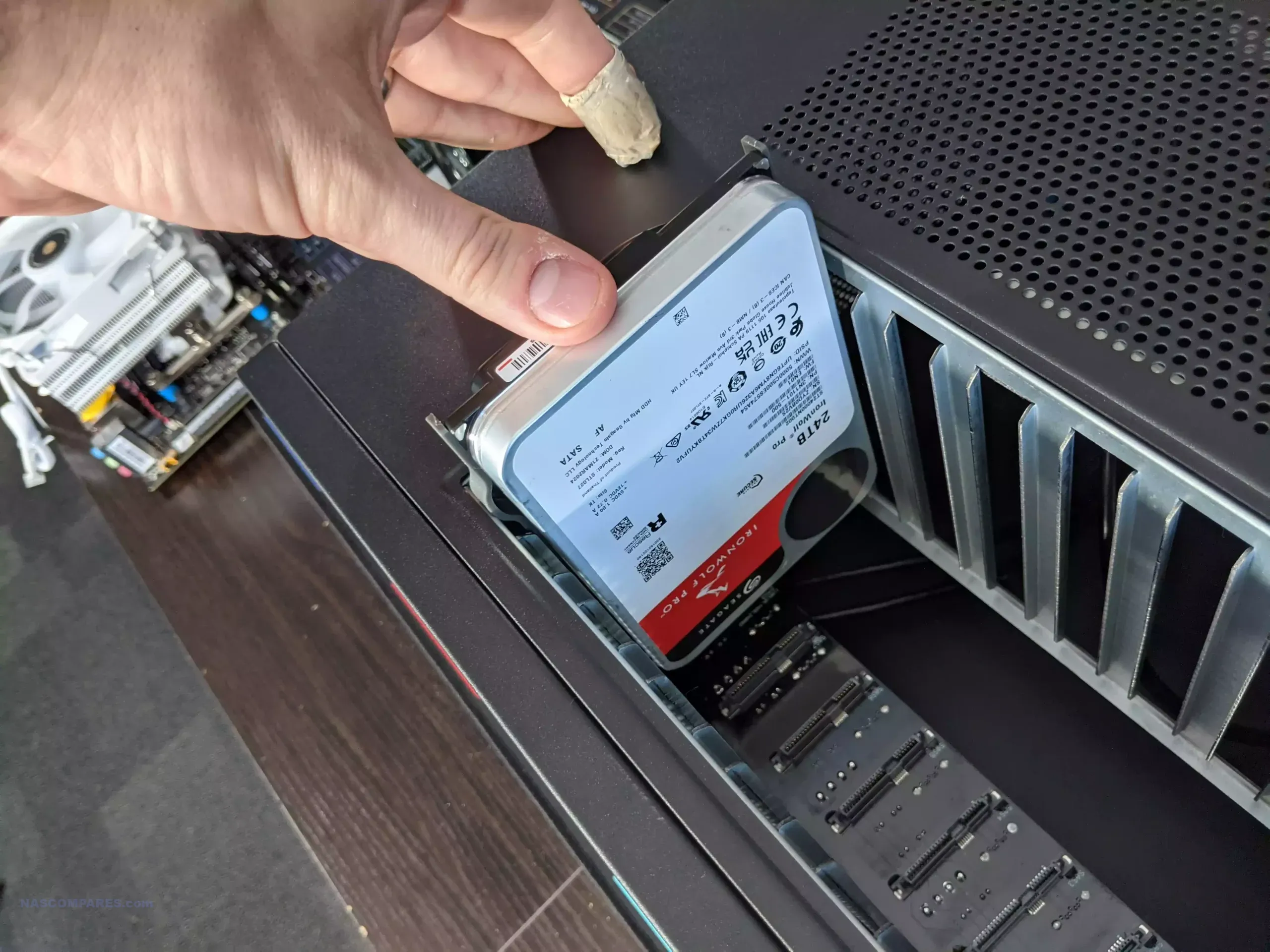
As an ATX/MATX/MITX NAS case, there is ALOT to love here! But I do feel that Phalcomm dropped the ball in terms of the management of the HDDs and SSDs. They do a GREAT job in creating a more compact NAS case and, sort of a few tight spots around the physical cooling, they have achieved what they were going for here. But the SATA storage bays are not great and whether its a budget constraint or a design choice, this system needed trays BADLY!
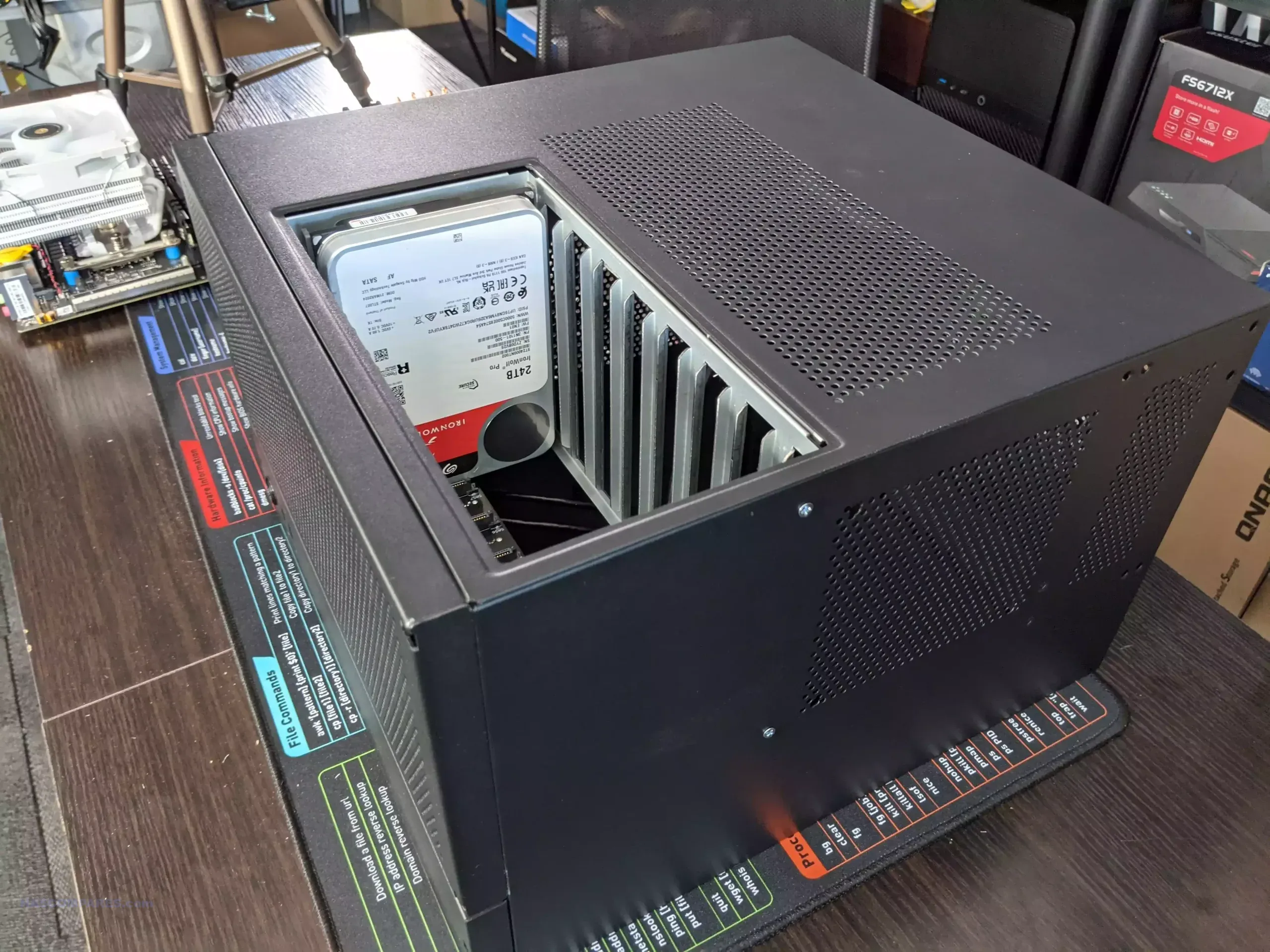
Phalcomm / STUDEVOXL8 Case Review – Conclusion and Verdict
Overall, I WANT to like the Phalcomm NAS case… I really do. It’s a compact NAS case that has very, very broad Mobo, CPU, Cooler, PCIe and PSU support – THIS IS ALWAYS GOOD! However, they managed to drop the ball in how they approached the storage and I cannot see any good reason why they decided against dull but dependable tray deployment. The price point is fairly reasonable vs it’s competitors in 2024/2025… perhaps a pinch higher, but give it’s specifically compact design and scalability, I am prepared to give them a pass on the price tag. But, much like the (now old, old skool) Fractal Node 804, the approach towards the storage here in the L8 feels like a big step back vs other DiY NAS serves in the market. The Phalcomm L8 is a reasonable enough case, but one that I know will have BYO Server buyers occasionally scratching their heads. The L8 is NOT a bad case, but there are better cases out there.
 DEAL WATCH – Is It On Offer Right Now? DEAL WATCH – Is It On Offer Right Now?These Offers are Checked Daily
|
🔒 Join Inner Circle
Get an alert every time something gets added to this specific article!
This description contains links to Amazon. These links will take you to some of the products mentioned in today's content. As an Amazon Associate, I earn from qualifying purchases. Visit the NASCompares Deal Finder to find the best place to buy this device in your region, based on Service, Support and Reputation - Just Search for your NAS Drive in the Box Below
Need Advice on Data Storage from an Expert?
Finally, for free advice about your setup, just leave a message in the comments below here at NASCompares.com and we will get back to you. Need Help?
Where possible (and where appropriate) please provide as much information about your requirements, as then I can arrange the best answer and solution to your needs. Do not worry about your e-mail address being required, it will NOT be used in a mailing list and will NOT be used in any way other than to respond to your enquiry.
Need Help?
Where possible (and where appropriate) please provide as much information about your requirements, as then I can arrange the best answer and solution to your needs. Do not worry about your e-mail address being required, it will NOT be used in a mailing list and will NOT be used in any way other than to respond to your enquiry.

|
 |
Gl.iNet Slate 7 PRO Travel Router (and Beryl 7) REVEALED
Minisforum N5 MAX NAS - 16C/32T, 128GB 8000MT RAM, 5xSATA, 5x M.2, 2x10GbE and MORE
The BEST NAS of 2026.... ALREADY??? (UnifyDrive UP6)
How Much RAM Do You Need in Your NAS?
A Buyer's Guide to Travel Routers - GET IT RIGHT, FIRST TIME
Jonsbo N6 DIY NAS Case Review
Access content via Patreon or KO-FI
Discover more from NAS Compares
Subscribe to get the latest posts sent to your email.


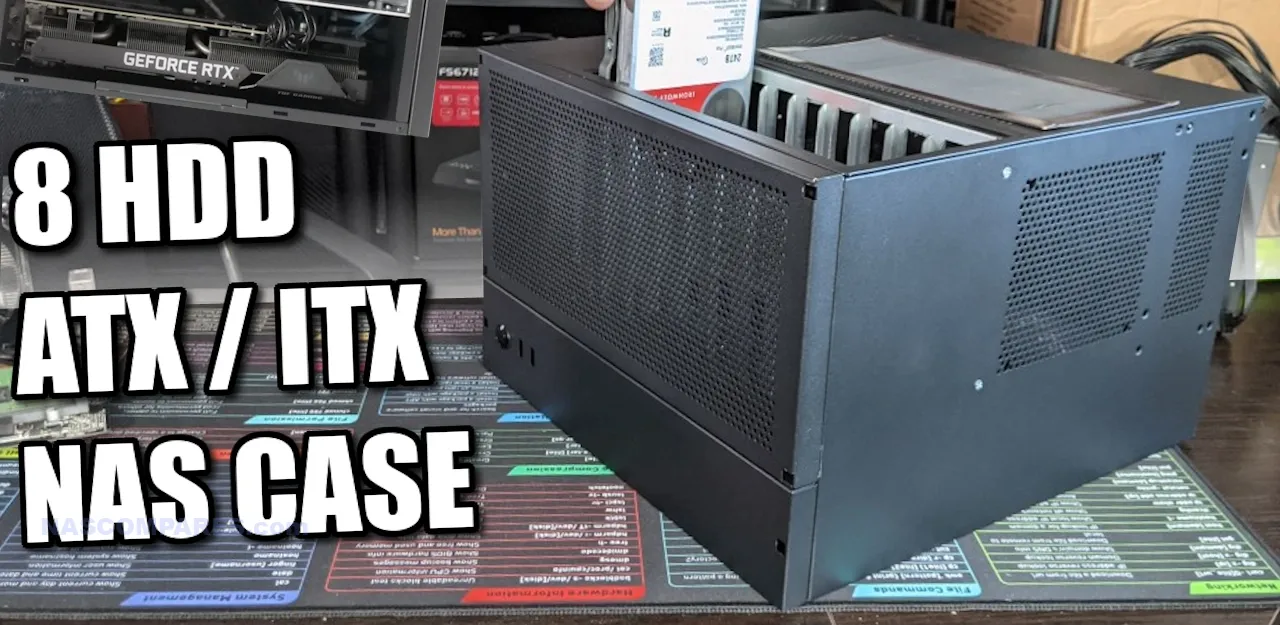

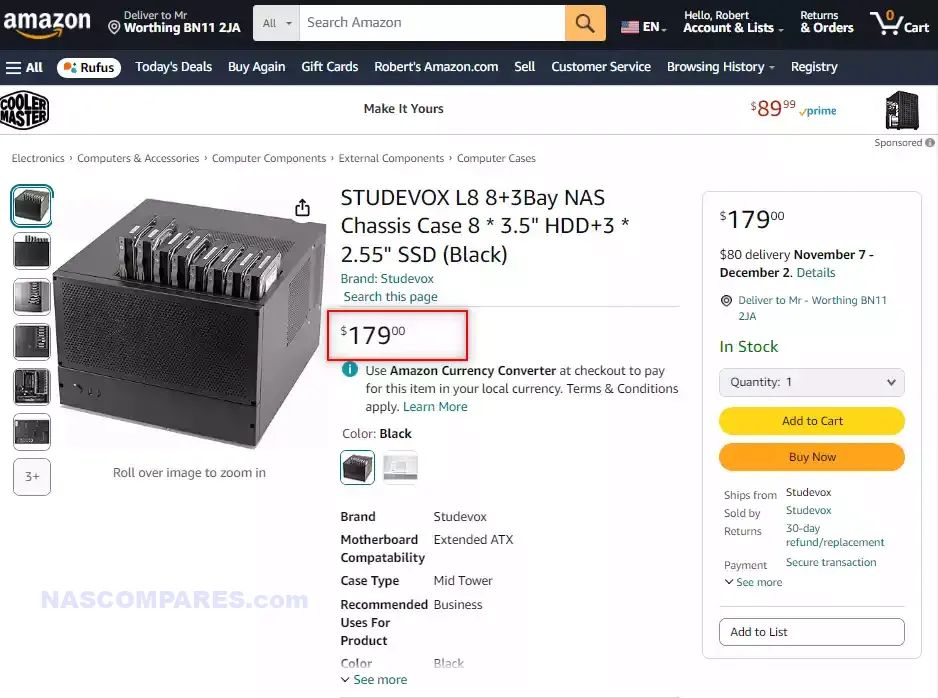




You mean to write the “HNAS Rectangle L-8” … As this is just a rebranded Chinese case that has been for sale for ages on AliExpress…